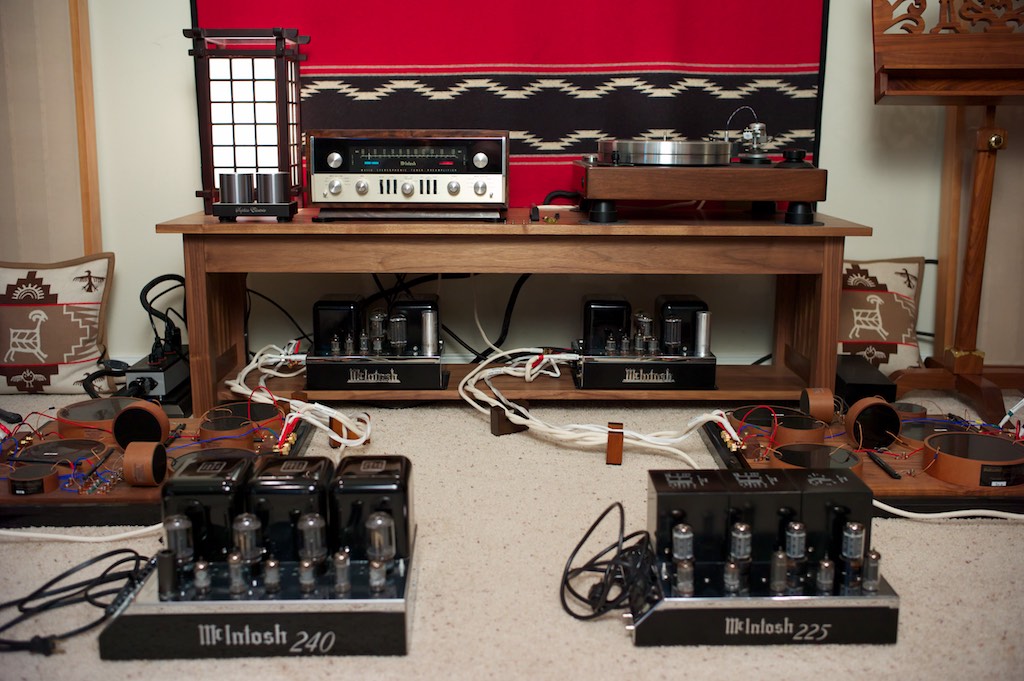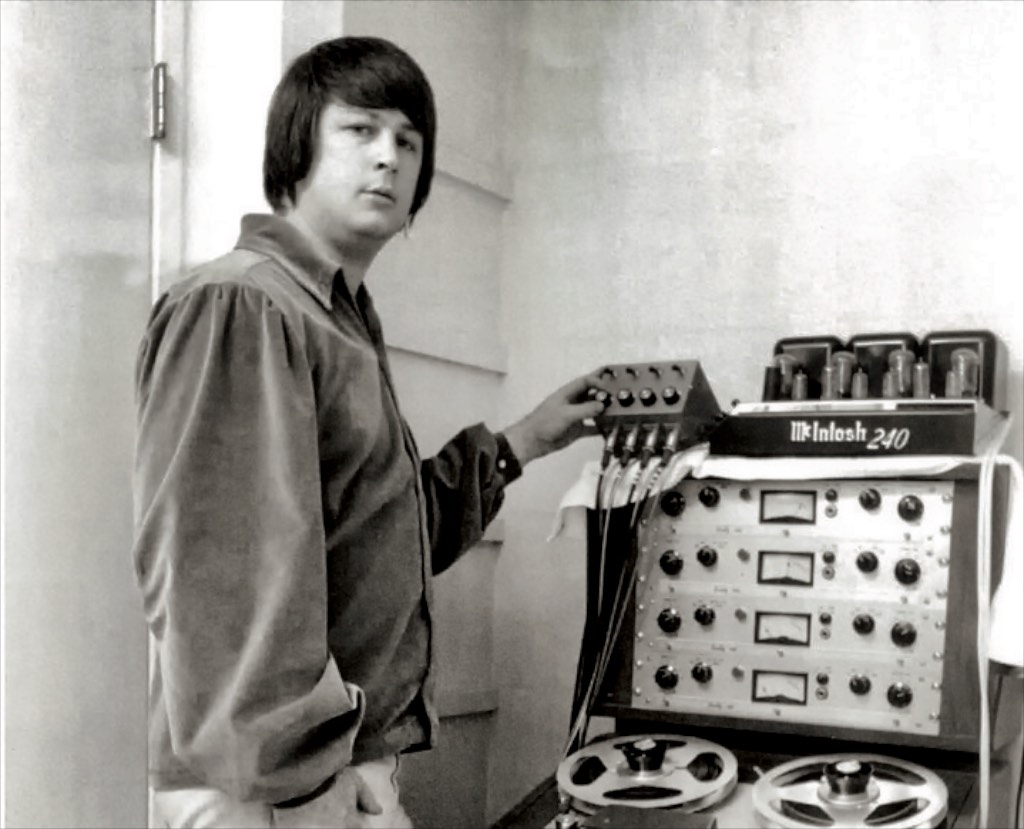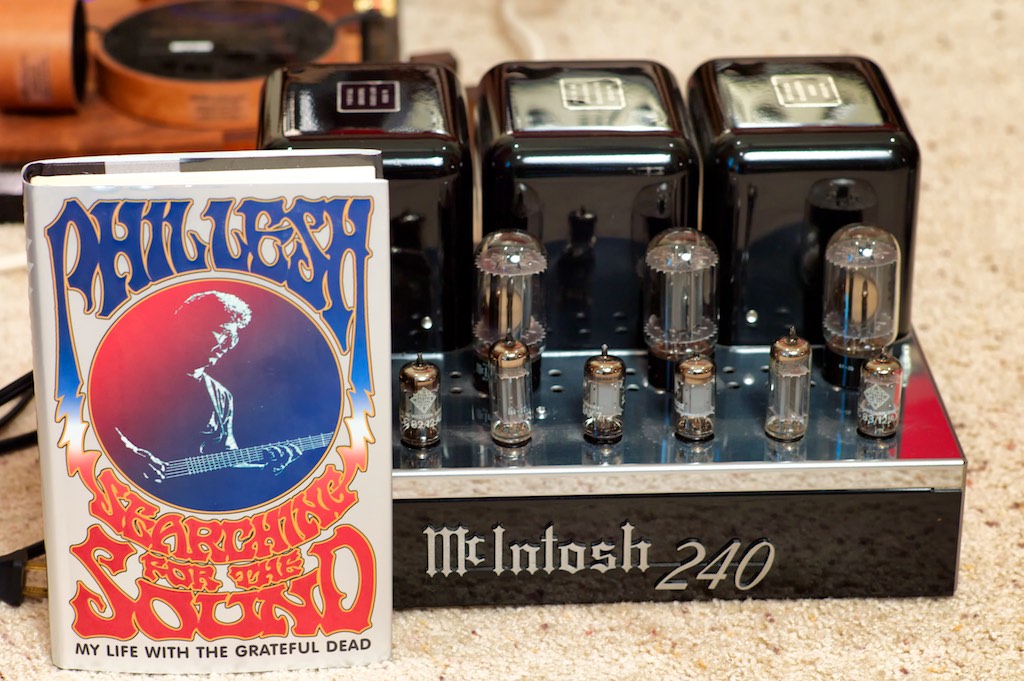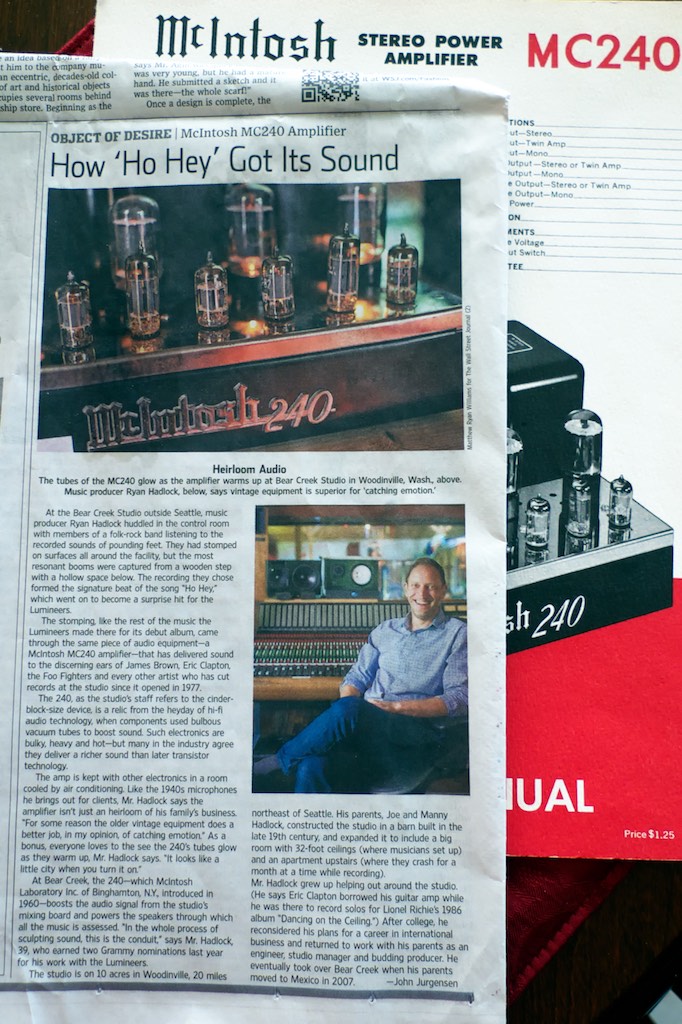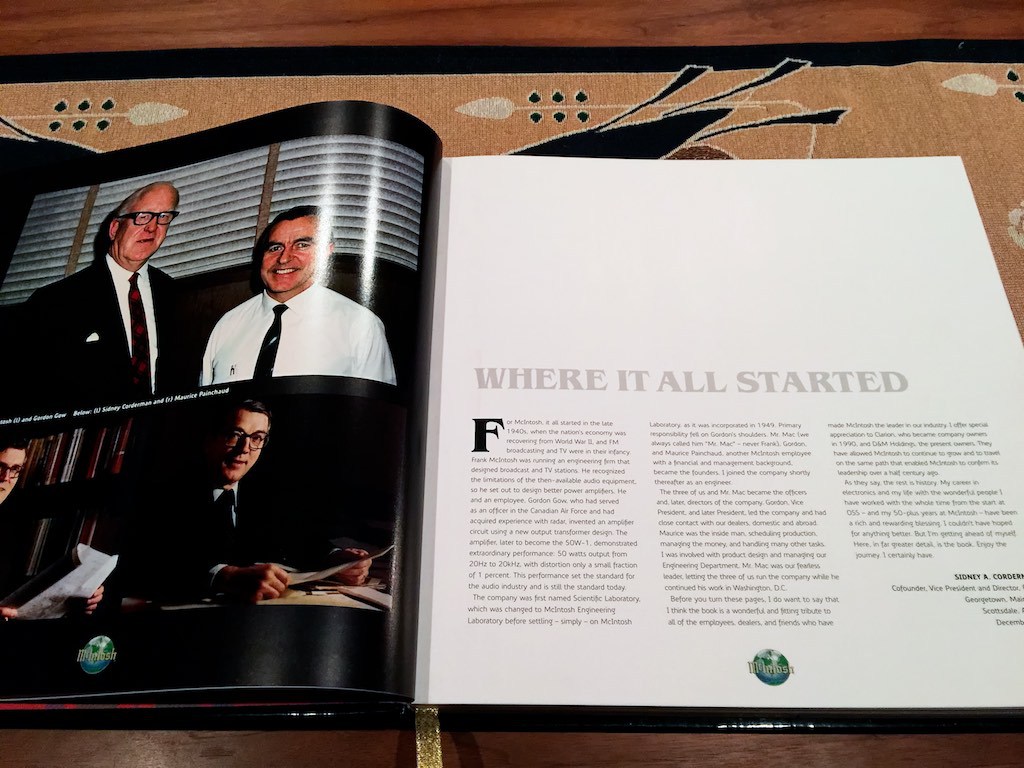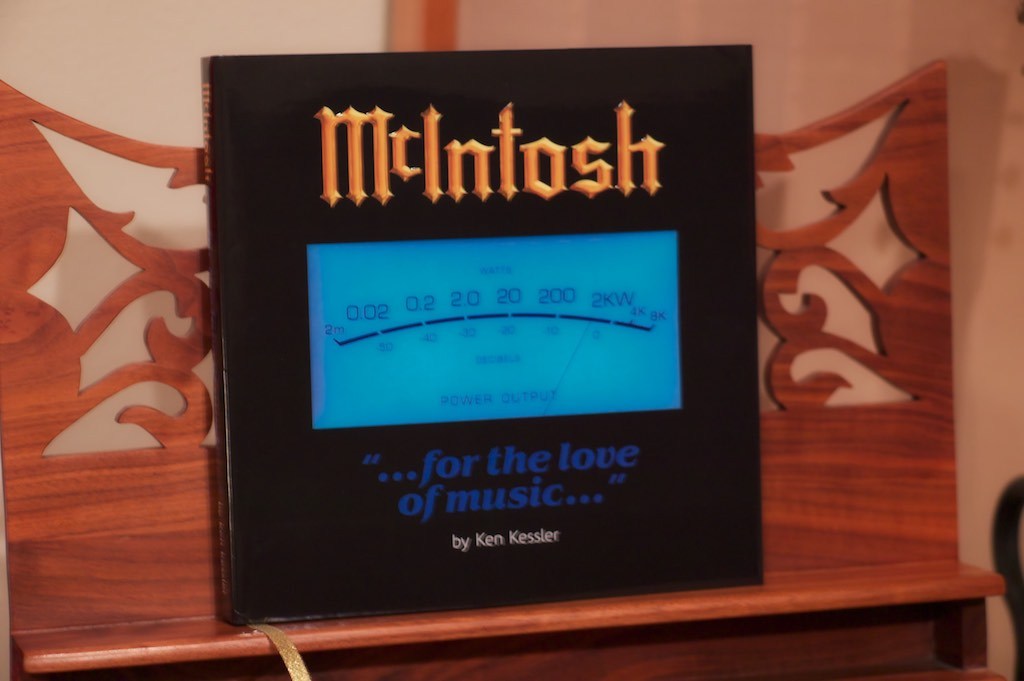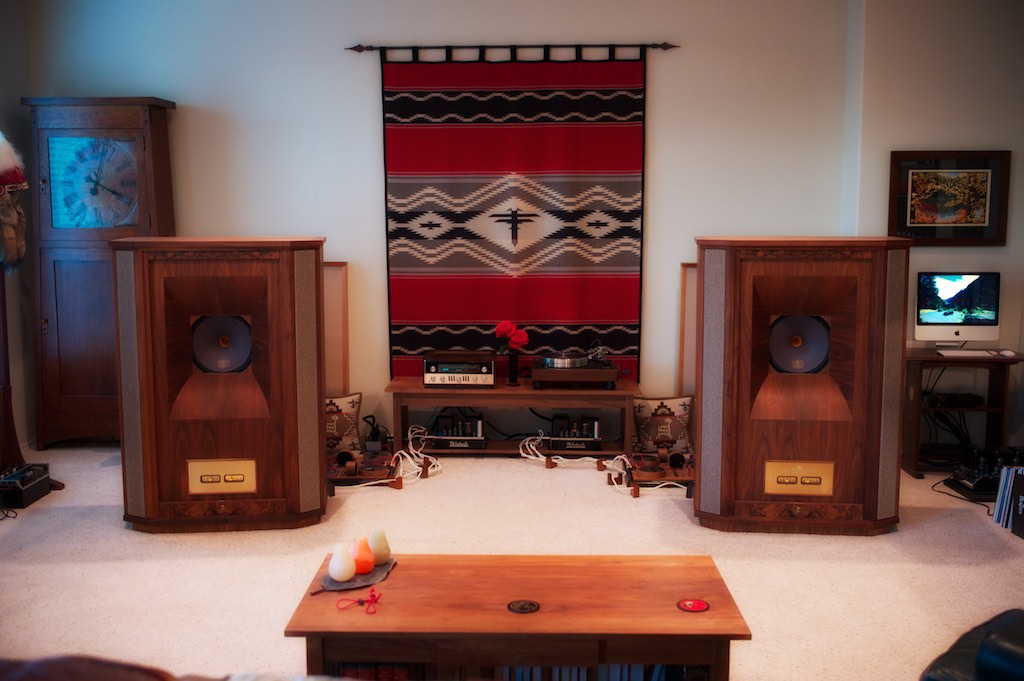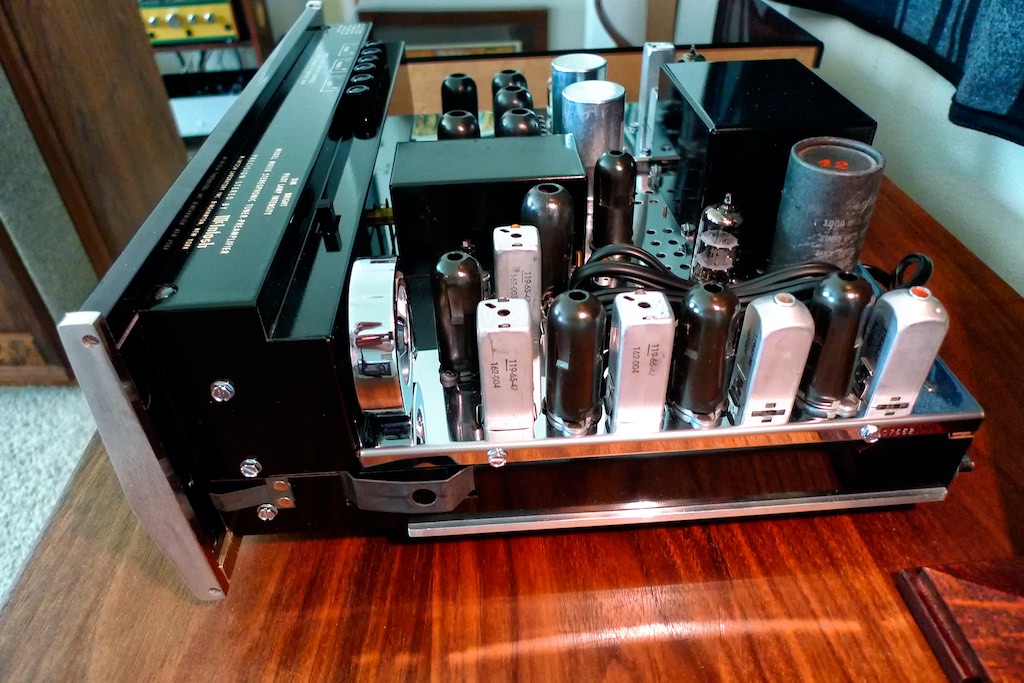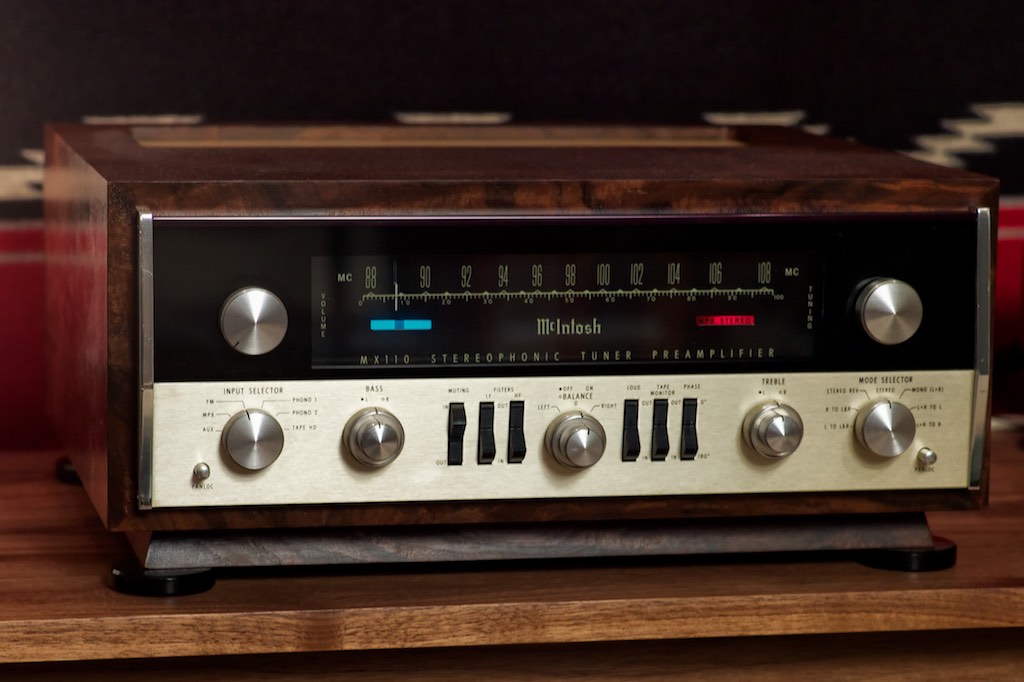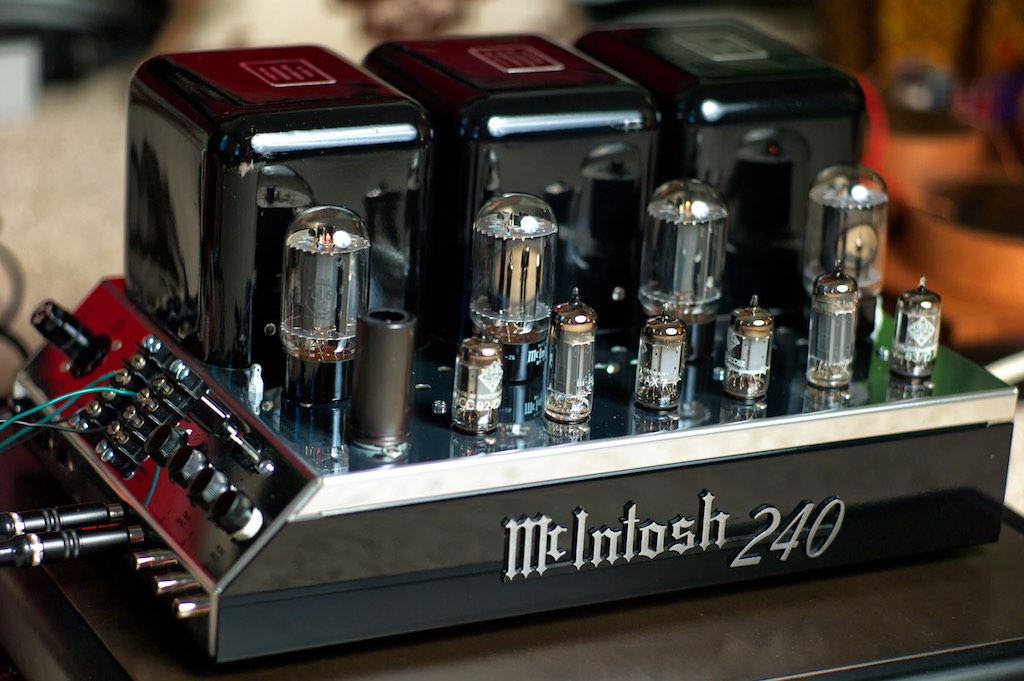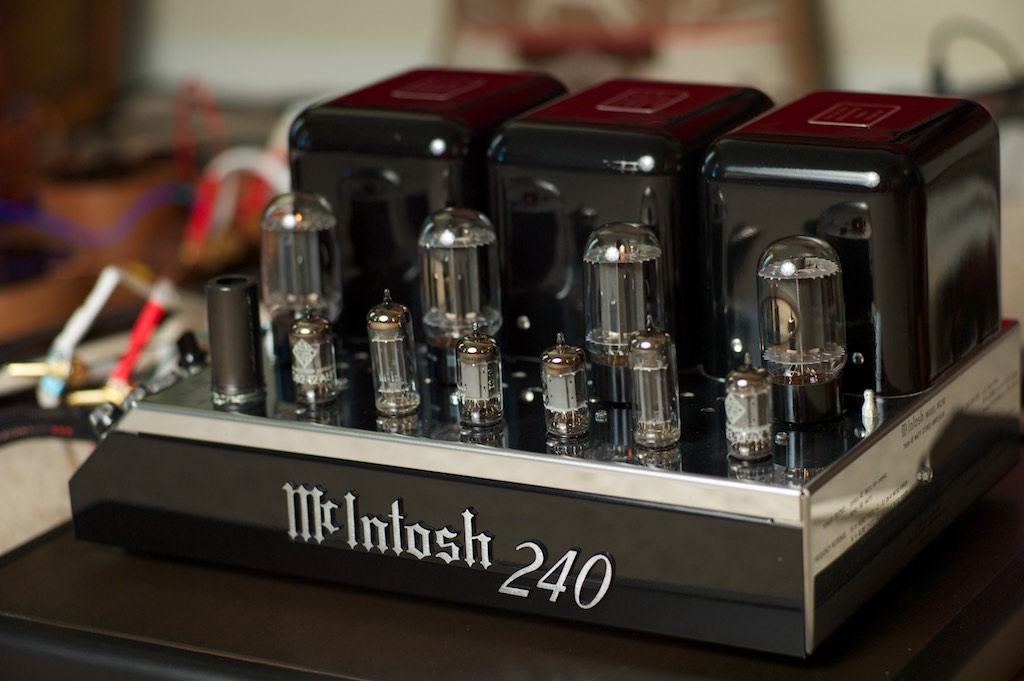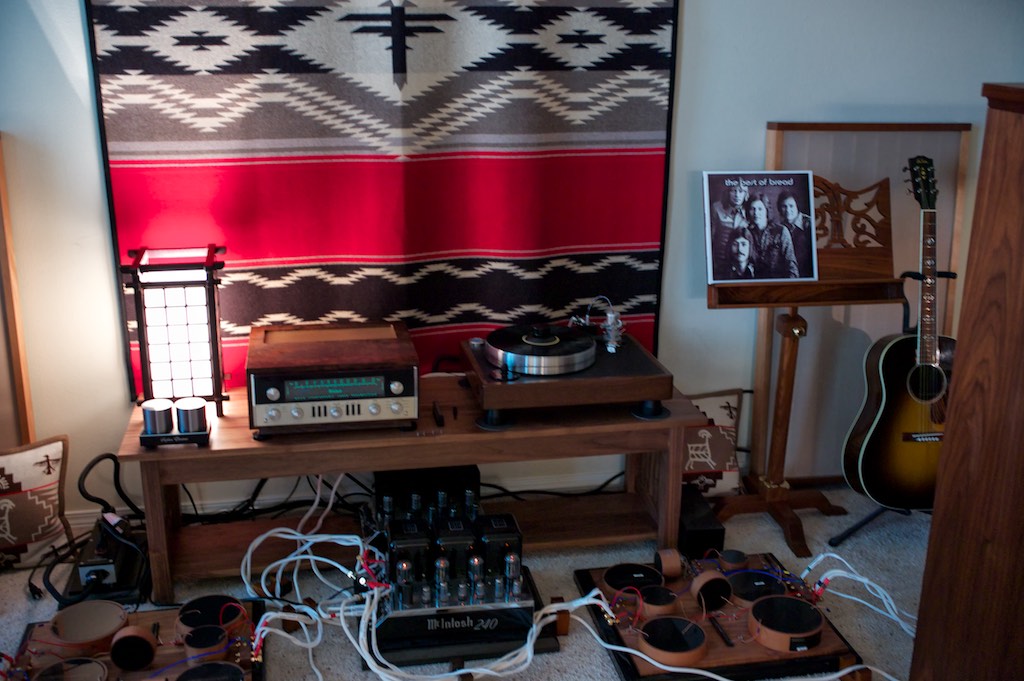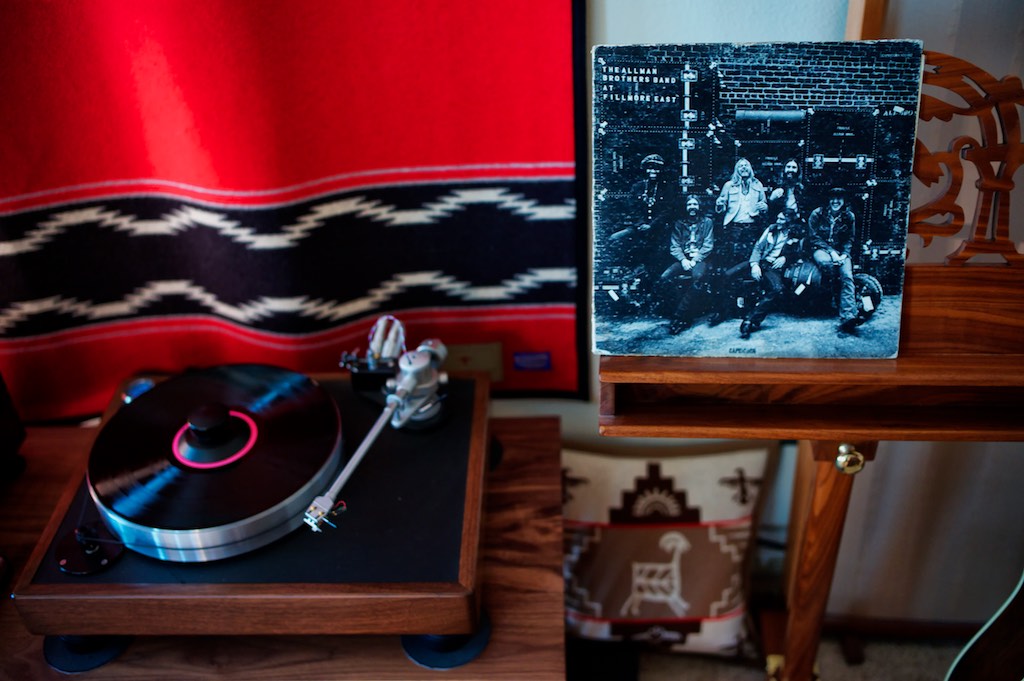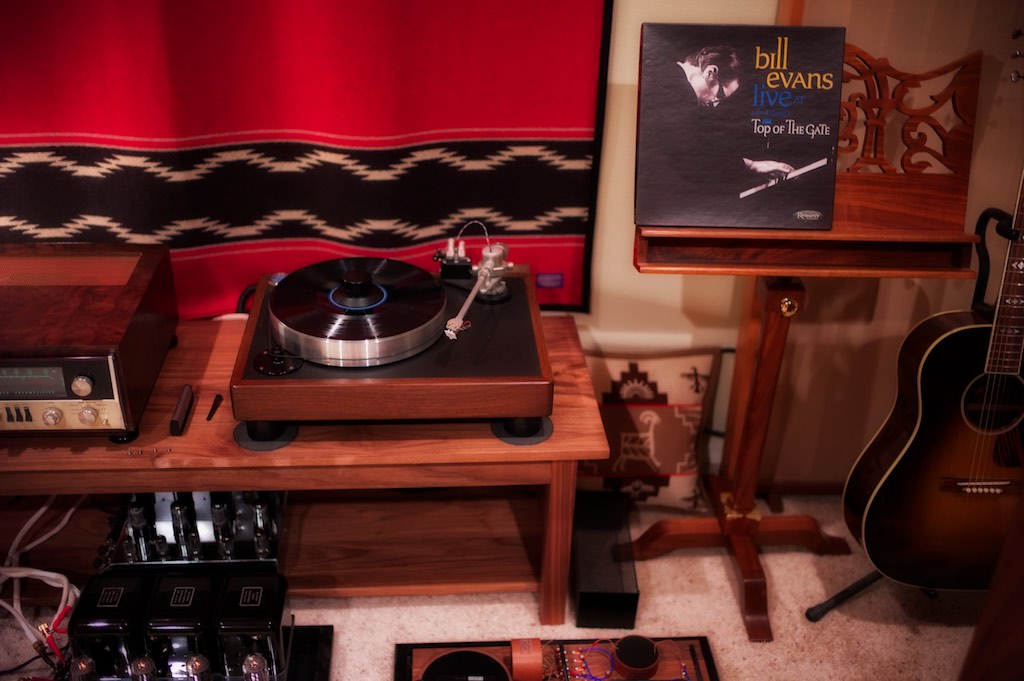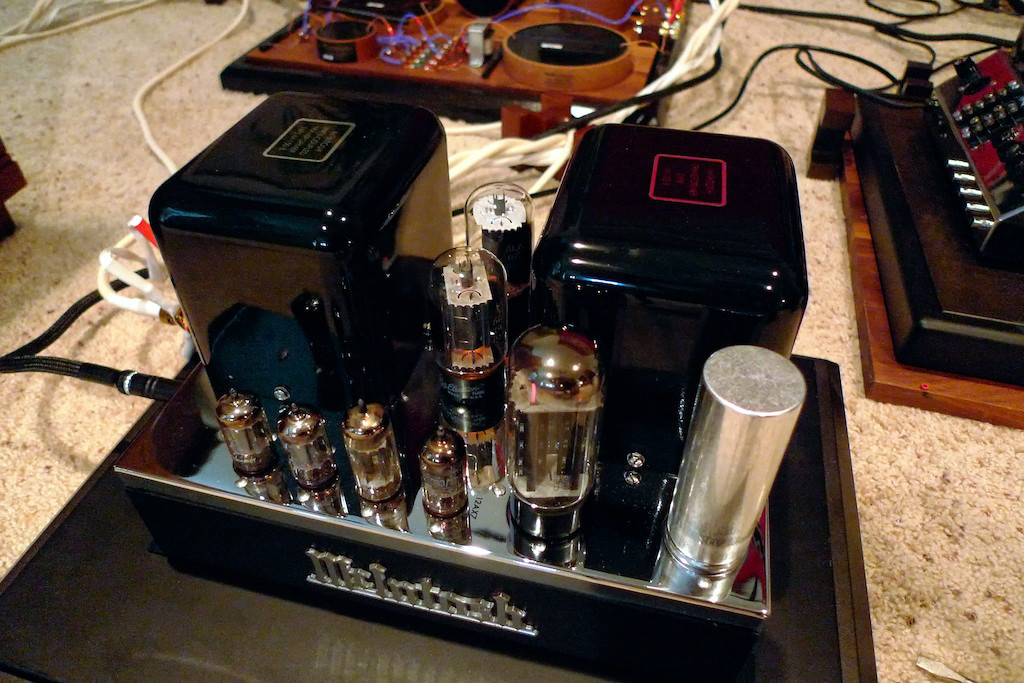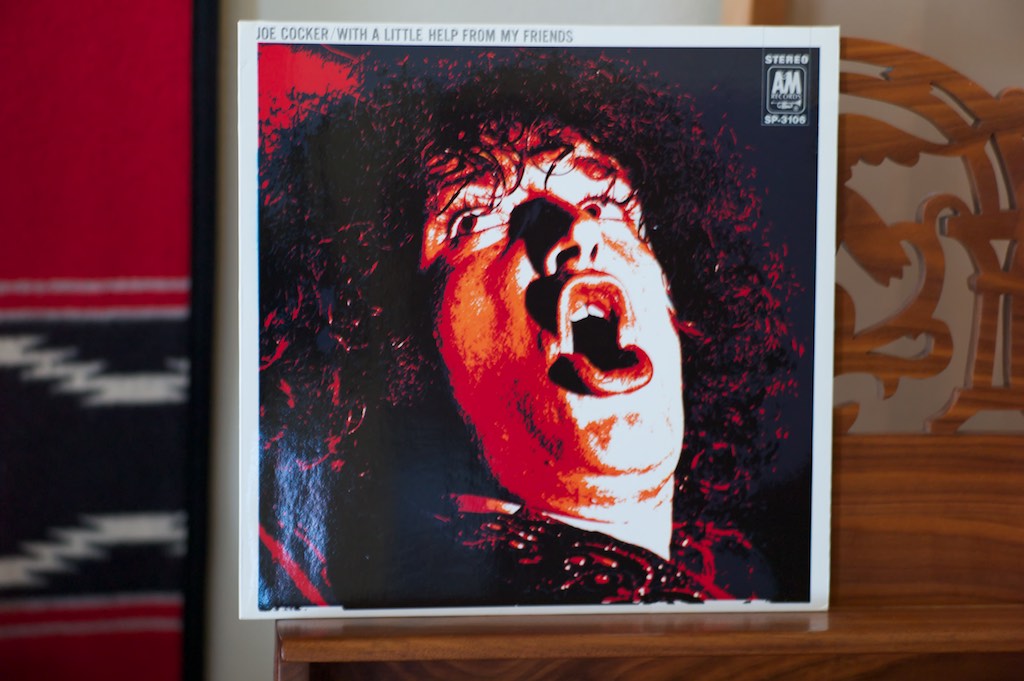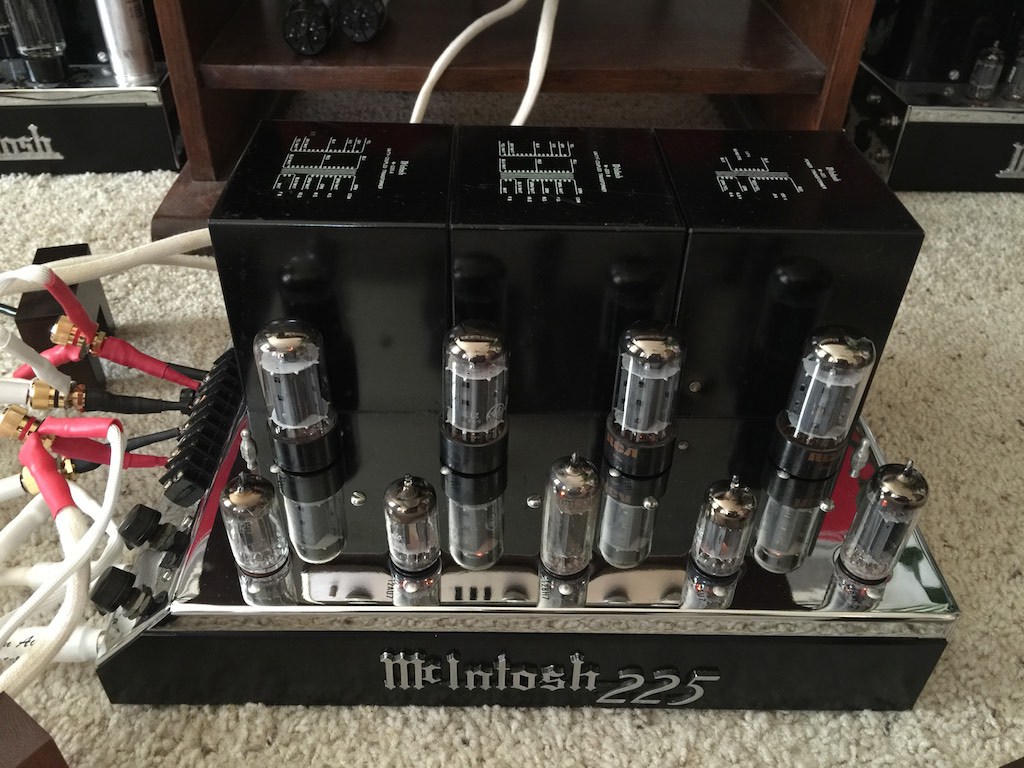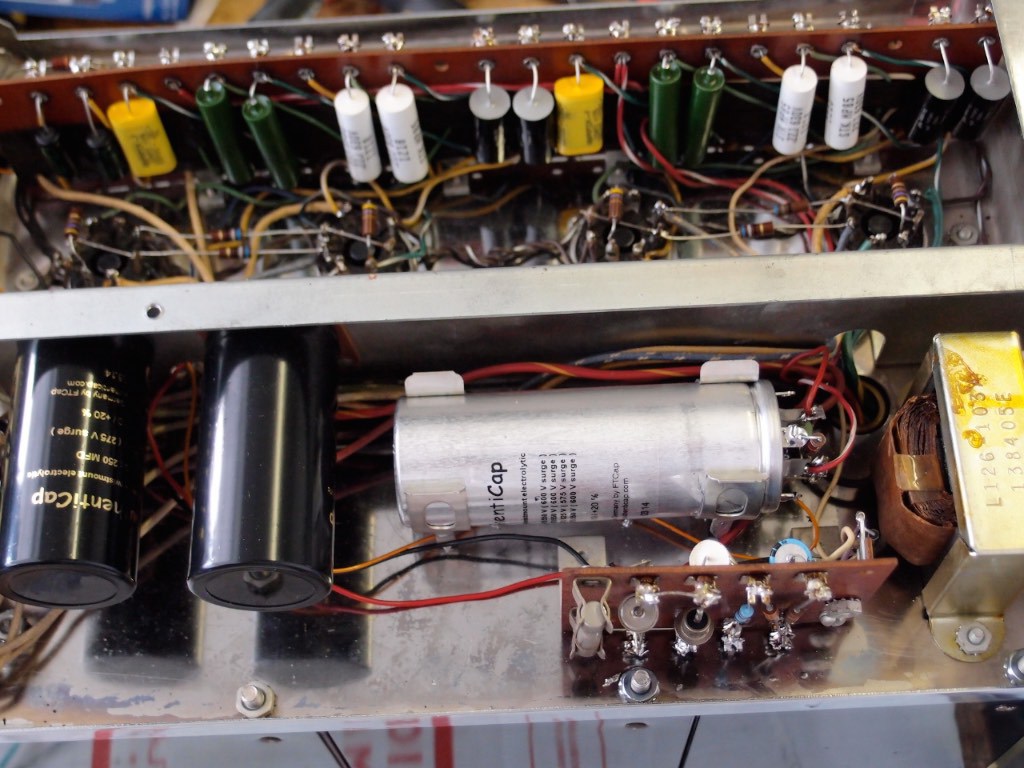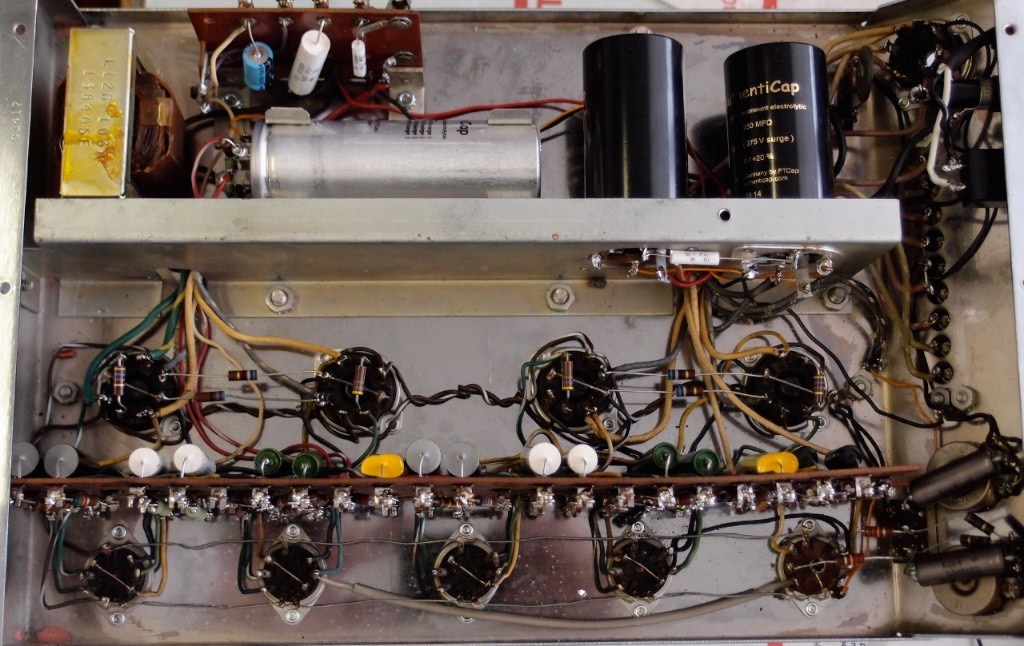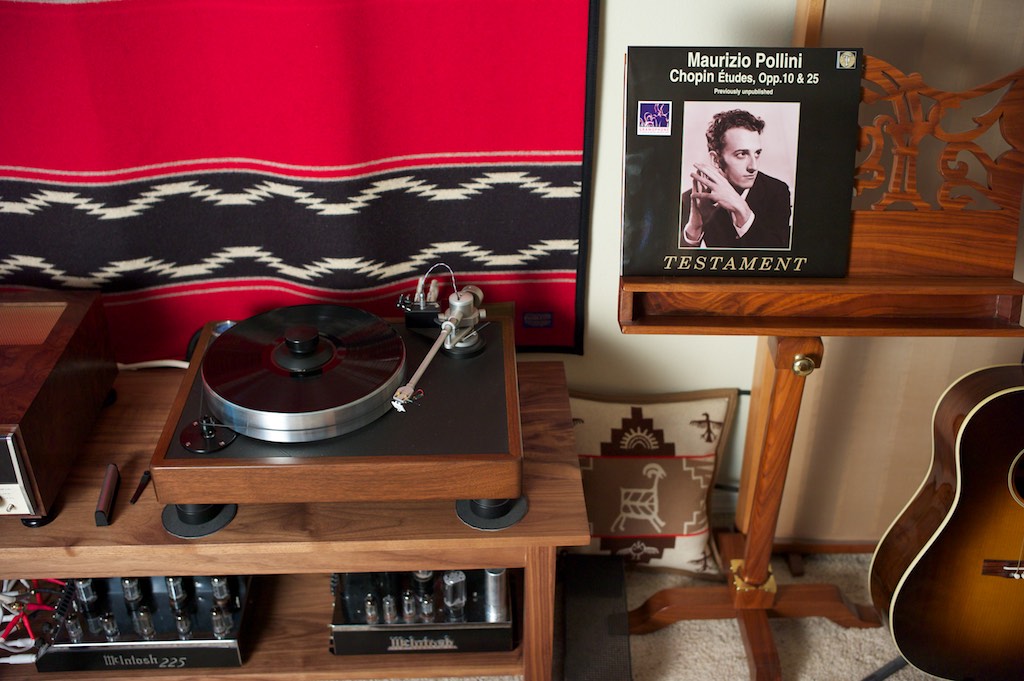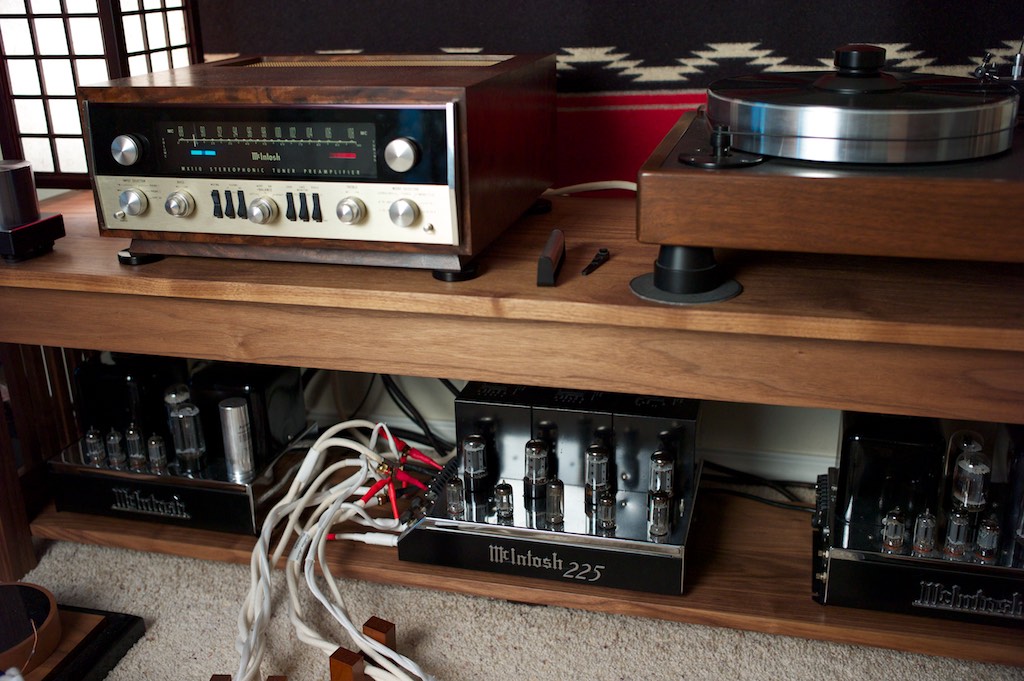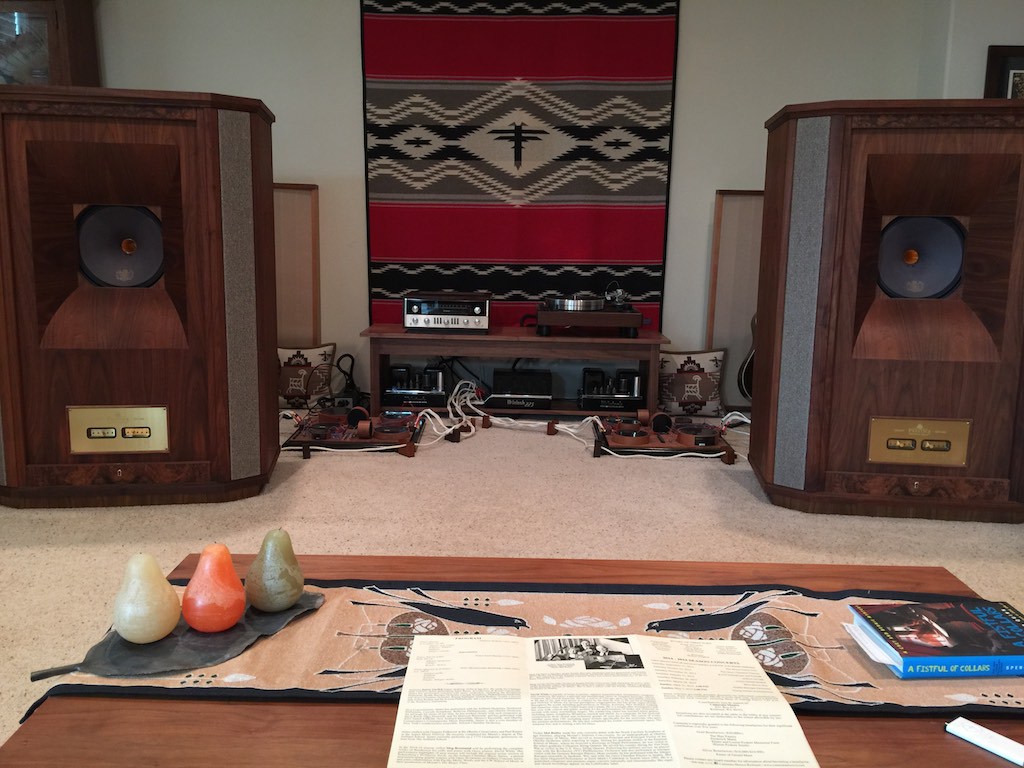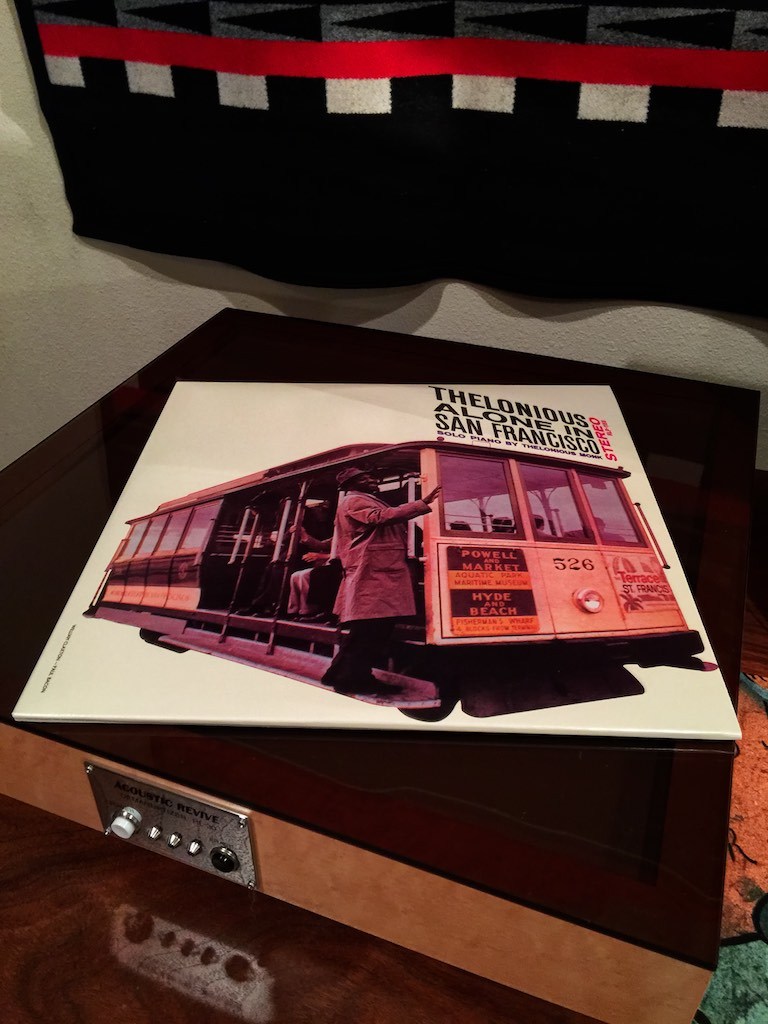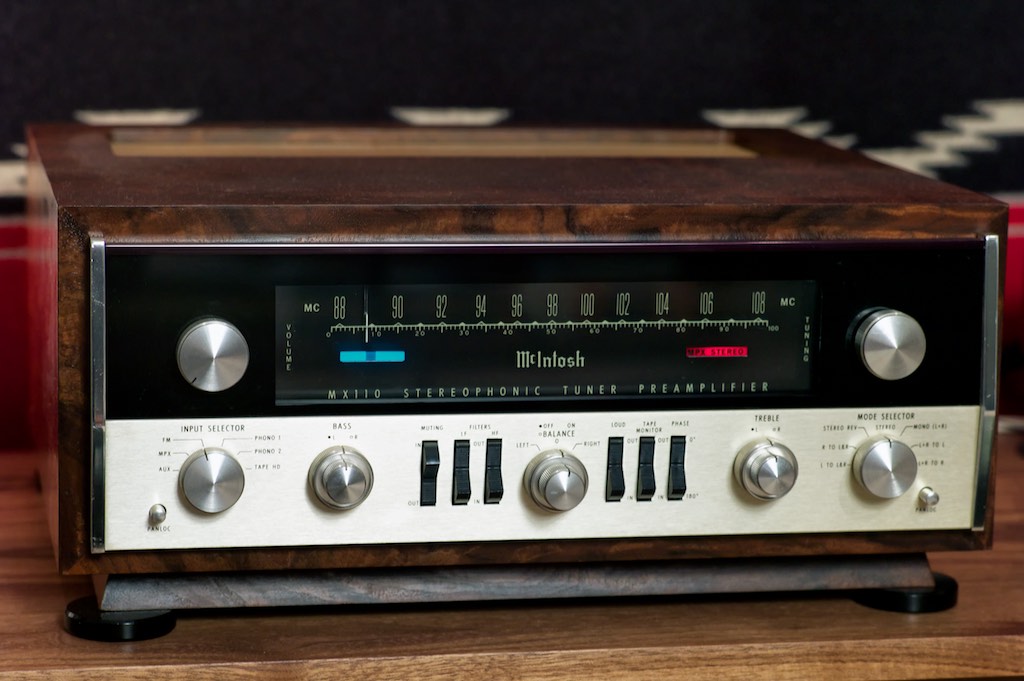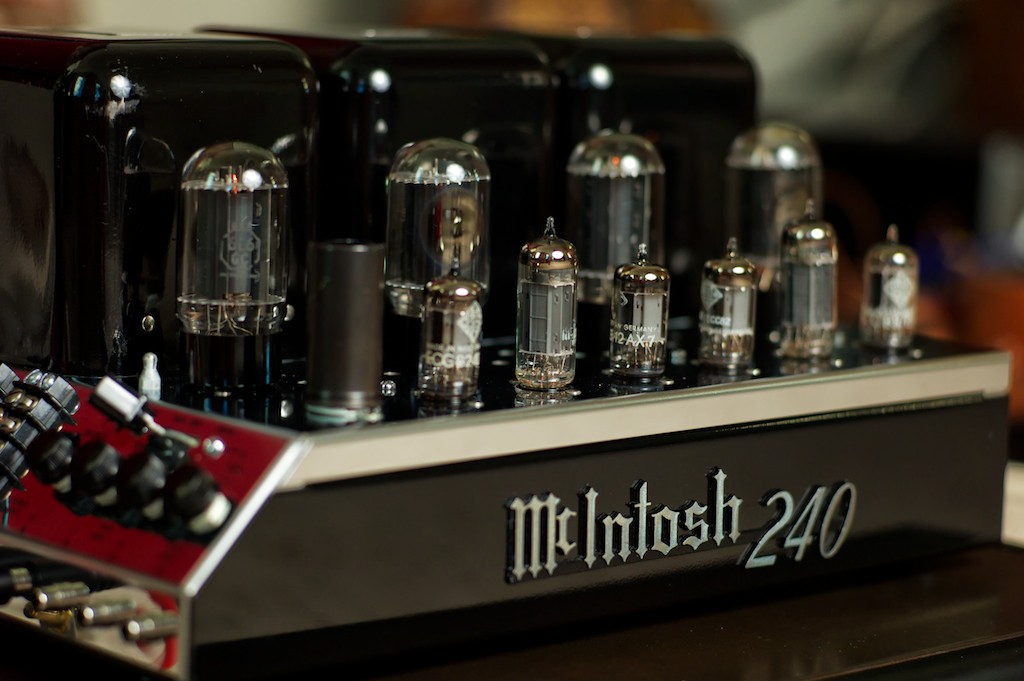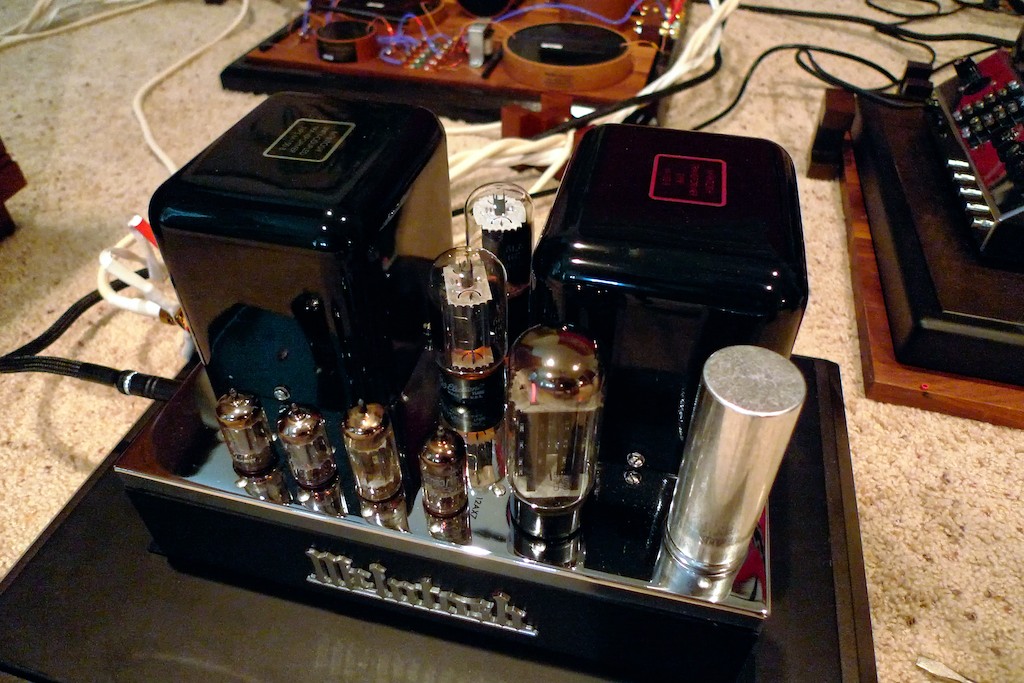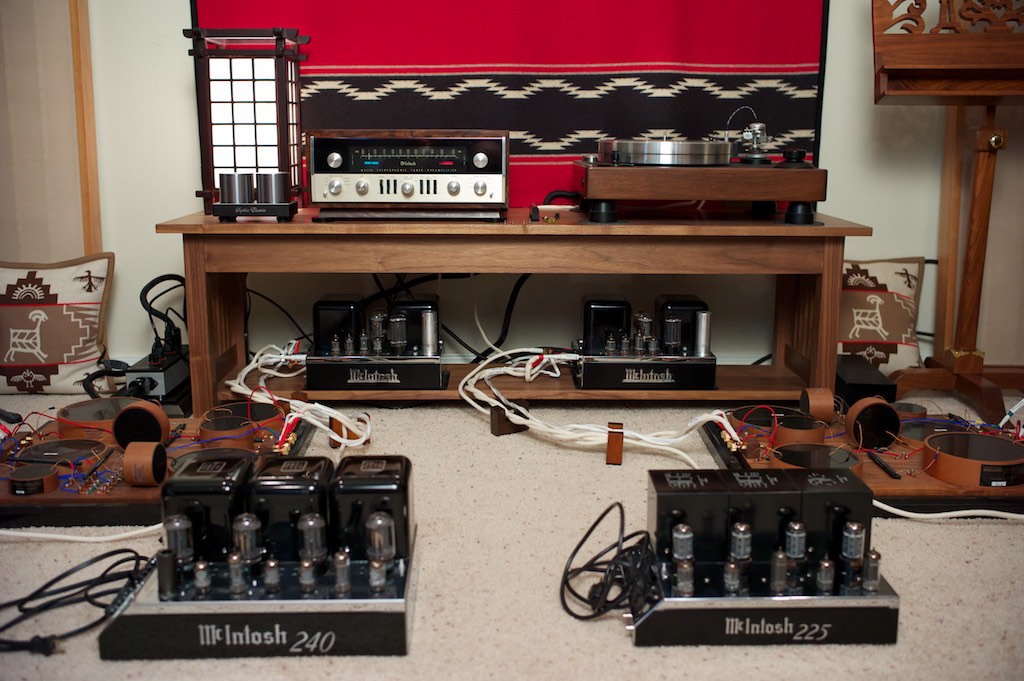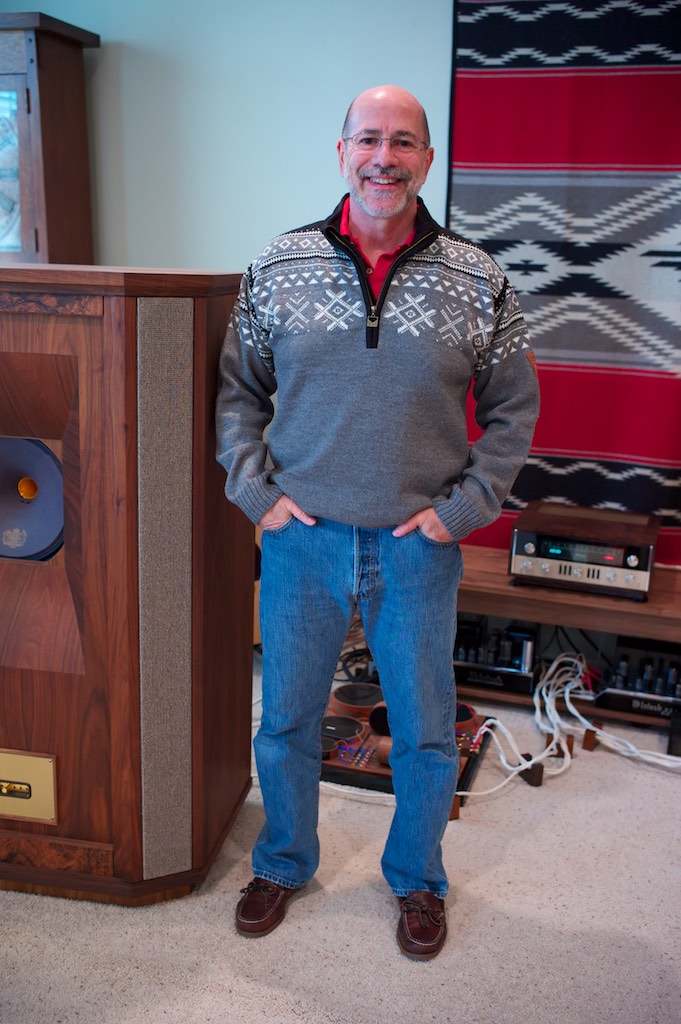'The Vintage McIntosh Experience' is now live at Positive Feedback Online! You can read it here.
In the text below I added a couple of additional comments that didn't appear in the original article at Positive Feedback Online. I tried to make the additions clearly visible so you don't have to look too hard for them.
The Vintage McIntosh Experience: A Musical Ride With The MX110Z Tuner/Preamplifier and the MC30, MC225, and MC240 Amplifiers
By Jeff Day
I’ve really had a lot of fun listening to vintage McIntosh vacuum tube audio electronics in my hi-fi system over the last year. The McIntosh MX110Z tuner/preamplifier, the MC30 monaural amplifiers, and the MC225 & MC240 stereo amplifiers were available as new products during the time period between 1954 and 1969, depending on the model, and now about 50 years later they have been delighting me with their musical charms in ways that few modern audio products have matched. They have also been reliable, and at least for now, their price in the vintage market is such that almost any audio enthusiast can afford them. In my book, that’s a very laudable set of qualities!
It makes me happy to own something as musical, reliable, and affordable as these vintage McIntosh electronics, and there’s also a certain sense of nostalgic satisfaction that comes from owning something as historically significant as the equipment that Brian Wilson of the Beach Boys mastered Pet Sounds with, or the gear that powered the Woodstock music festival in 1969, or that the Grateful Dead used to power their 28,800 watts Wall of Sound in concert. McIntosh.
When I was reading Phil Lesh’s book, Searching for Sound, about his life as the Grateful Dead’s bass player, I was fascinated to read his description of their Los Angeles ‘pink house’ practice system in 1966: “The equipment was set up in the living room: the “lead sled” of Mac amps (four McIntosh 240 stereo tube amps running mono, one for each electric instrument – two guitars, bass, and keyboard – bolted onto a single sheet of two-inch plywood), the Altec “Voice of the Theater” speakers (huge woofer and horn combo speakers, four in all, one for each amp), and all the drums and instruments. The volume level of this gear was enough to bulge out the sides of the house when we cranked.”
It turns out that McIntosh is the weft to music’s warp that makes up the fabric of musical history in the USA. Quite a number of classic music festivals used McIntosh for their amplification mojo, including Woodstock, the Newport Jazz Festival, the Newport Folk Festival, Fillmore East, the Concert for Bangladesh, and Madison Square Garden, to name a few. There were also quite a few bands that used McIntosh on tour, including the Grateful Dead, The Beach Boys, the J. Geils Band, Jefferson Airplane, Janis Joplin, Al Kooper, Blood Sweat & Tears, and others.
McIntosh has also been used in studio production work, like that of Brian Wilson for Pet Sounds, or the Columbia Records Studios in San Francisco, New York, and Nashville. I was pleasantly surprised when I opened up a recent issue of The Wall Street Journal and read about Grammy® nominated producer Ryan Hadlock, who still uses a McIntosh MC240 in his Bear Creek Studio today: “… Mr. Hadlock says the amplifier isn't just an heirloom of his family's business. "For some reason the older vintage equipment does a better job, in my opinion, of catching emotion."”
McIntosh electronics have not only been used to listen to music with by enthusiasts, but also to make music with, and there are very real reasons why musicians have chosen McIntosh to provide amplification for their home hi-fi systems, their musical instruments on stage, and for their work in the studio, and those same reasons might make these vintage McIntosh electronics the perfect choice for you to listen to music with today at home.
In 1947 Frank McIntosh and Gordon Gow designed a breakthrough audio amplifier with wide bandwidth & low distortion using a new transformer design that used two primary windings in parallel instead of in series, as was the norm for the day, and called their breakthrough transformer Unity Coupled. Frank McIntosh incorporated McIntosh in 1949, with co-founders Gordon Gow and Maurice Painchaud. Sidney Corderman joined the company as an engineer shortly thereafter, and Tom Rogers and Larry Fish coming to the engineering team a bit after that, and as they say, “The rest is history!” For an excellent read about the detailed history of McIntosh, I encourage you to pick up a copy of Ken Kessler’s book McIntosh, which you can get directly from McIntosh here for a $150 USD.
I group my fellow vintage McIntosh audio enthusiasts into two schools, the first being the collector who wants everything to be as original & pristine as possible, with only new old stock parts (or their closest sensible replacement) used to minimally electrically refresh them; and the second being the enthusiast listener, who just wants to enjoy listening to music with restored vintage McIntosh gear because of its considerable musical prowess, and who doesn’t mind if its been cosmetically restored and modified a tiny bit with artful combinations of caps & such to get the most out of them musically. I suppose I fall into both categories, and I have examples of both, and appreciate both perspectives. But if push comes to shove, I suppose I’ll side with the enthusiast listener in saying that it’s ok to do cosmetic restoration, and to use an artful selection of components to coax the maximum musical performance from these vintage McIntosh gems.
My McIntosh MX110Z tuner/preamplifier and MC240 stereo amplifier fall into the collector category, being Mint Plus and Mint, respectively. The purchases and electrical restorations of my MX110Z and MC240 were through the McIntosh vintage specialist team of Tom Manley & Terry DeWick of McIntosh Home Audio & DeWick Repairs.
My McIntosh MC30 monaural amplifiers and MC225 stereo amplifier fall into the enthusiast listener category, and were purchased from Yves Beauvais at Vintage Vacuum Audio, who did the cosmetic & electrical restorations of them, and voiced them with a very artful choice of components & vacuum tubes to get rather astounding musicality & sound quality from these vintage jewels.
The Review System
For this article I used my Tannoy Westminster Royal Special Edition loudspeakers with the magnificent external Duelund Coherent Audio CAST crossovers, as described in Positive Feedback Online Issue 70 and Issue 74. The internal WRSE wiring, speaker cables, and analog signal chain interconnects were all Sablon Audio Panatela. My VPI Classic turntable was fitted with a classic EMT TSD-15 phono cartridge. Sablon Audio Gran Corona AC power cords connect my iMac & Mhdt Labs Havana USB DAC. For digital duties I used a very long pair of Acoustic Revive Single Core PCOCC-A interconnects to connect the Havana to my preamplifier. As always, I used a wide variety of the very effective Acoustic Revive audio accessories that I have written about in many previous articles. The amplification electronics discussed in this article are my restored vintage McIntosh MC225, MC30, and MC240 valve amplifiers, and the MX110Z vacuum tube tuner/preamplifier, that were all purchased at full price from vintage specialists Tom Manley or Yves Beauvais.
The McIntosh MX110Z Stereo Tuner/Preamplifier
The McIntosh Mx110Z stereo tuner/preamplifier sold from 1962 to 1969 for the princely sum of $399 USD, which would be approximately $1952 in 2014 US dollars. My fully refreshed Mint+ MX110Z from the vintage specialist team of Tom Manley & Terry DeWick rang in on the cash register at around $3000 in 2014 US dollars. How many pieces of audio gear have evaluated like the vintage McIntosh’s have over the years? Not many.
The MX110Z may be somewhat bewildering to contemporary audio enthusiasts that are used to the stripped down, minimalist, preamplifier designs of today, as the MX110Z sports both an FM tuner and equalization controls within its open vacuum tube chassis. Like me, after living with the MX110Z for a while, you may wonder why all modern preamplifiers don’t include FM tuners and equalization controls - they’re great fun! Also, tell me, is there anything even remotely comparable to the vacuum tubed McIntosh MX110Z currently available today at any price? No, which is a pity.
For a good description of the MX110Z, let me quote its owner’s manual, “The MX110 combines in one unit an extremely low-distortion preamplifier with a highly sensitive FM multiplex stereo tuner. Every desirable feature of a tuner and a preamplifier is included in this design. Interstation noise suppression, tuning indicator, FM multiplex indicator, individual channel bass controls, individual channel treble controls, electronic phase switch have all been engineered into the MX110. The input selector gives you a choice of six different program sources. The mode selector is a newly developed control which makes it very easy to balance a stereo system. It is designed to add left to right for monophonic operation, to control the left to right stereo perspective or to compare the left and right channels of a stereo program. The loudness of the phono channels and the auxiliary channel may be balanced to the tuner loudness. These adjusting controls are located on the top of the MX110 behind the front panel. … The McIntosh MX110 is a beautifully engineered control center for the finest stereo sound systems. The extreme care in manufacturing, in layout design and in thermal engineering promises the usual McIntosh extra values of reliability, performance, and long life.”
I checked in with Tom Manley about finding a really sharp looking example of a McIntosh MX110Z so it would look nice in photos at my blog, Jeff’s Place, and in the photos for my Positive Feedback Online articles. Tom told me he had one that was in ‘Mint Plus’ condition, which meant looked like it was almost brand new out of the box, which for what I wanted was perfect!
The MX110Z contains the surprising number of 27 vacuum tubes, but fortunately, the MX110Z is easy on tubes, and after a checkup & refreshment you can expect to go a very long time before having to change any tubes out. Tom sent my MX110Z to Terry DeWick for a check-up, tuner alignment, and any needed electrical updates. Terry DeWick has been doing audio repairs and restorations for over 40 years (since 1962), has a sterling reputation, and can do complete cosmetic and electrical restoration of your favorite vintage McIntosh, Fisher, or other vintage jewel. Terry is also an ‘Authorized McIntosh Labs’ warranty repair specialist for McIntosh, if you need repairs on your Mac that still has a warranty. Terry includes a report of the measured data for each unit after he restores/repairs it so you know what was done and how it turned out.
McIntosh wasn’t kidding about “reliability, performance, and long life,” when they wrote that owner’s manual, as after a brief checkout & refreshment by Terry DeWick, my 50-year-old’ish MX110Z is now ready for another 50 years of delivering musical satisfaction, which means it will outlive me to bless someone else’s life with music after I’ve left Planet Earth. Now that’s really incredible! If you have children that you would like to leave a musical heirloom to enrich their future lives, please take note. Vintage McIntosh, it is the gift of music that keeps on giving.
So what’s it like to live with and use a vintage McIntosh MX110Z tuner/preamplifier as your daily music machine? Overall it is pretty wonderful, but there are a few vintage peccadillos that come with owning a MX110Z that you should be aware of, so let me get those out of the way first.
First of all, the vintage RCA connectors used in the MX110Z - while completely usable - are a bit of pain in the behind, as their spacing is closer together than with most modern RCAs, and the jacks are a bit shorter. That means you’ll need to use slim-line male RCA connectors on your interconnects for them to fit properly on those elderly female RCAs. The small-diameter version of the male Vampire Xhadow RCAs that Mark Coles’ uses on his Sablon Audio Panatela interconnects worked perfectly in this vintage application from a mechanical perspective, and are sonically & musically the bees knees with the MX110Z. The Acoustic Revive Single Core RCAs also work swell.
The second downside is that the MX110Z has the scrawny captive AC power cord typical of the Golden Age period of hi-fi history, which means I’m giving up the rather substantial performance boost that comes with using something like the Sablon Audio Gran Corona AC power cord, for example. Mark Coles suggested a work-around for me on that issue, which is to snip off the standard power cord, leaving just enough to wire up an Oyaide Power Inlet R IEC connector, heat shrink it, and then plug a high-performance Gran Corona power cord into it to power up the MX110Z. I cringe a bit at the thought of that approach on my ‘Mint Plus’ MX110Z, but it does make sense, so maybe I’ll consider giving that a try in the future.
Now let’s talk about the many upsides of the MX110Z. The first upside of the McIntosh MX110Z is about the high degree of visual satisfaction I get from it. Every time I look at my MX110Z, I get that warm glow of the pride of ownership that vintage McIntosh gear so easily evokes. With its elegantly backlit glass FM tuner top-panel, its tastefully gold-anodized bottom control-panel, and its polished chrome chassis with glowing vacuum tubes, my MX110Z adds up to one gorgeous piece of hi-fi gear that makes me feel lucky to own something so special. I wrapped my MX110Z in a gorgeous walnut burl veneered cabinet that was handcrafted by Matt at McIntoshCabinets.com ($410 USD including shipping), which I think further adds to its beauty.
From a practical standpoint, the MX110Z’s FM tuner, line & phono sections are nice and quiet in operation, which means that the MX110Z is a great match even for my sensitive (99dB) Tannoy Westminster Royal Special Edition loudspeakers. Another plus is that the MX110Z’s phono section has enough gain that you don’t have to use a step-up transformer to get adequate volume from the higher output moving coil phono cartridges (like the EMT TSD 15 that I normally usually use), which I really appreciate. Speaking of the phono stage, it also has two inputs, so you can run a mono-cartridged tonearm into one phono input, and your second stereo-cartridged tonearm into the second pair of phono inputs, giving you the ability to switch mono-to-stereo and back again as your album choice dictates (hint: preview of coming attractions from the upcoming The Garrard Project 2015 article).
The McIntosh MX110Z tuner/preamplifier is a great deal of fun to use on a daily basis. I love listening to music or the news through the FM tuner while I’m cooking dinner, writing an audio article, or just lounging on the couch with a good book. I bought a Magnum Dynalab ST-2 vertical omnidirectional FM antenna ($114 USD) that works fantastic with the MX110Z, and it’s amazing how well it brings in even the hard-to-get stations. Highly recommended. The sound quality from the FM tuner is extraordinarily good, with lots of natural sounding detail, a big spacious soundstage with well-defined images, and an effortless, liquid, rich musicality that is full of color, life, and gorgeous tone that can nearly rival the sound of the best vinyl records, making the MX110Z’s FM tuner positively mesmerizing to listen to music with. I love it.
The MX110Z’s line stage is every bit as wonderful as the FM tuner, with the same sort of effortless, liquid, rich musicality that is full of color & life & gorgeous tone. I’ve been particularly enjoying listening to the Jazz 24 streaming jazz station via my Apple iMac & Havana USB DAC digital front end through the MX110Z’s line section, which yields a presentation of surprisingly analog-like richness that nearly rivals that of the FM tuner, and even the phono section itself.
The line section of the MX110Z is really, really good, but don’t just take my word for it, read what mastering engineer extraordinaire, Steve Hoffman, said about listening to CDs through his MX110Z’s line section at his blog:
“I let the McIntosh warm up for an hour or so and left the room, playing my usual break in disk "Romantic French Fantasies", John Longhurst at the organ console of the Mormon Tabernacle at Salt Lake City on Klavier KCD 11069. It's wicked good for tube warm up break in with some really head banging organ stuff. At any rate the disk ended, I came back in the nice warm room and put on the same stuff I was playing earlier in the day. Sat in the same spot, let it rip after adjusting the volume.
Let me just say that the unit is as quiet as a mouse. Didn't hear anything, no buzzing, hum or anything to tell me that it was on. Very quiet. First I played the Nat King Cole "Just One Of Those Things" album, the second song "A Cottage for Sale" in stereo. Has nice dynamics, tonality, life like sound, etc. Holy cow, it sounded wonderful on the MX-110. I mean spooky real. I was astounded at how good it sounded. The McIntosh was really holding it's own in the system.
Now, of course, the bass suffered from a bit of slow down. The macro and micro dynamics were also missing a bit and this is where the Concert Fidelity line stage excels (and for $20,000.00 it ought to) but the McIntosh reproduced the sound with authority and a really spooky 3-D sound that is not like real life, but larger than life.
Interestingly, the tonality, the crucial thing, stayed pretty much the same in the system, which was really interesting to me. Usually these old tube pieces are quite colored. Not this gem. I played the Beach Boys and Ella Fitzgerald "Clap Hands" and some Ray Charles Atlantic stuff, the Beatles, the Art Pepper, a Deep Purple cut, the usual mismosh. Everything sounded so interesting with this MX-110.
Not totally accurate but a sort of enhanced reality brought on by this liquid, expressive mid-band that just took my breath away. Of course, it's fun for only so long in this system and then I need to go back to reality. It's like eating the hot fudge out of the jar. You really dig it but you couldn't do it for breakfast, lunch and dinner, dig?
But I can tell you that the old time engineers really knew what they were doing and this preamp/tuner from 1966 really held up under the strain of being the key component in a majorly expensive and wonderful sounding system.
My point? I dropped this antique thing into the heart of a world class stereo system and the sound didn't go to hell, it stayed right up there in Groovyland. It will do the same for you if you have a modest system or a fancy shmancy system.”
I agree whole-heartedly with what Steve said about the MX110Z, with the exception that I do think it makes a wonderful ride as a daily listener too, and as Steve points out, it turns digital media into your friend, which is something special in itself. I don’t plan on letting the MX110Z out of my system any time soon, and I’m definitely hooked on its considerable charms.
While I really love listening to the MX110Z’s FM tuner, and the line section when streaming digital, it is the phono section that really gets me excited. While I was chatting with Steve a while back on Facebook about one of his posts, I mentioned the sweet synergy I was getting from my vintage McIntosh MX110Z & MC30 combination with my Tannoy Westminsters, and Steve said, “Jeff, that's how I use my Mac 30s as well, an MX-110Z into Tannoy Lancasters. Can't beat that sound. Makes me happy, especially playing records.”
I can say that playing records through the vintage McIntosh MX110Z’s phono section makes me happy as well, and depending on your hi-fi priorities it might do the same for you. So what is it about the MX110Z that makes me so happy?
Simply put, the MX110Z excels at playing music in an authoritative and vivid way that is very emotionally engaging. First of all, the MX110Z presents melodies, harmonies, and rhythms with a natural life-like momentum & dynamics (albeit with a very slight dynamic diminution at the micro & macro extremes compared to some of the very best modern gear), and tempos are portrayed so that both the mood and speed of the music are conveyed through it, just like with music in real life. Secondly, the MX110Z’s tonality is superb by any standard past or present, and it excels at the reproduction of the textures, colors, tones and overtones that timbral listeners will revel in.
The MX110Z – and vintage McIntosh gear generally – plays music at live-like loudness (dB) levels very realistically, or as Steve put it, ‘spooky real.’ When I’m really into listening to an album for the live-like music experience, I like the loudness level to be similar to live loudness levels for the kind of music I’m listening to, which for the kind of music I listen to the most, jazz, usually means around 80 dB or louder. I’ve also found the MX110Z to be very musically compelling when listening to music across a wide spectrum of volume levels too, from very soft background levels, all the way to blow-the-windows-out rock & roll levels.
The MX110Z is nicely transparent, which allowed me to hear deeply into the music-making fabric of a recording, and it throws a nice big three-dimensional soundstage with a large sense of ambient space, putting it in the same general league as any of the modern high-performance gear I’ve had in my system to listen to. The MX110Z isn’t quite as resolving as some of the most resolving modern gear, but it’s close enough that I didn’t care.
Taking all of the MX110Z’s positive musical & sonic attributes together, its ability to make FM, digital, and vinyl sources all sound like a magic music experience, it's truly a marvel of hi-fi accomplishment from the Golden Age of audio electronics that more than holds its own with anything today, and it is easily worthy of being at the center of any fine audio system.
The McIntosh MC240 Stereo Amplifier
The McIntosh MC240 stereo amplifier sold from 1960-1969 for around $288, depending on the year. That’s about $1409 USD in 2014 dollars, and like the MX110Z tuner/preamplifier, the MC240 has appreciated considerably more than its value in adjusted 2014 dollars. For a ‘Mint’ original MC240 that has been professionally electrically restored you can expect to pay $5000 or more.
As I mentioned earlier, I purchased my vintage collectable ‘Mint’ McIntosh MC240 stereo amplifier from Tom Manley of McIntosh Home Audio in Knoxville, Tennessee, USA, whose specialty is vintage and pre-owned McIntosh audio gear, and it was electrically restored and fine-tuned by Terry DeWick, who does all of Tom’s restoration work. My MC240 included a fine vintage tube set (RCA 6L6GC black plates, Western Electrics, Telefunkens, etc.), original documentation, an original shipping box, which was all packed into a protective shipping container that Tom did a really nice job putting together.
The ‘2’ in MC240 means two-channels, or stereo, and the ‘40’ means it provides 40-watts per channel, and with the addition of a couple of jumper wires & the flip of a switch you can turn the MC240 into an 80 watt mono amplifier. The 40-watt per channel stereo McIntosh MC240 measures 8" H by 10.75" D by 17.25" W and weighs a hefty 56 pounds. The MC240’s terminal strips have connections for 4, 8, and 16-ohm loads. The response of the MC240 is16Hz to 40kHz (+0 -0.1dB), which means it can go deeper and higher than most contemporary loudspeakers can. The tube complement is one 12AX7 that drives both channels as a voltage amplifier, two 12AU7s as phase inverters, two 12BH7s as drive amplifiers, two 12AX7s as cathode followers, four 6L6GCs as outputs, and it has solid-state rectification.
So what is it like living with a restored vintage McIntosh MC240 stereo amplifier as a daily musical ride? It is a sweet ride, just like with the MX110Z tuner/preamplifier. Before I delve into all the MC240’s positive aspects, let me get the vintage peccadillos out of the way first: the MC240 has a non-detachable power cord, so you can’t easily take advantage of the considerable performance gains that come from an accessory power cord like those from Sablon Audio or Acoustic Revive. The MC240 uses vintage terminal strips that work best with bare wires inserted into them. The Sablon Audio Panatela speaker cables I use with my Westminster Royal SE loudspeakers are terminated with spade connectors, and the smart thing for me to do would be to re-terminate them as bare wires, which work best with the MC240’s terminal strips. In the meantime I have been using bypass adapters I made as a DIY project, which actually work really well, even though they look like they’re a short circuit waiting to happen. Also, vintage McIntosh amplifiers don’t have an on/off switch. I deal with the lack of an on/off switch by plugging all my vintage McIntosh hi-fi gear into an Acoustic Revive RPT-4 Ultimate Power Distributor, and then plugging or unplugging its power cord to power on/off the system.
After doing a little music listening with my ‘new’ vintage McIntosh MC240 amplifier it was easy to figure out why Brian Wilson used an MC240 to master Pet Sounds, as it sounds fantastic. While listening to the soft rock ‘Make It With You’ from the excellent Friday Music reissue of The Best of Bread LP, I was impressed how utterly natural and musical the MC240 came across, while still throwing a big & layered soundstage with vocals & instruments that were full of body, color, life, and beautiful tone. Then there’s that ‘spooky’ musical presence Steve mentioned for the MX110Z, making its appearance here too with the MC240, which made for engrossing listening sessions as it cast its spooky-captivating spell.
The MC240 proved capable of providing intense musical drive and energy too, as I heard while listening to my well-played original 1971 copy of The Allman Brothers Band’s At Fillmore East live blues-rock album (which in all likelihood they played live through the McIntosh amplification often used at Fillmore East during that period). While my At Fillmore East album doesn’t exactly have audiophile-style production values, it’s great music, and the MC240 endowed the Brothers’ blues-rock with lots of drive & energy that made the tempos, melodies, rhythms, and dynamics come alive and grab me by my musical balls, just like it should. The Allman Brothers Band’s intense & raw live music making on ‘At Fillmore East’ comes through with aplomb with the MC240 in the system. Want to rock out like in the glory days? The MC240 will deliver the goods!
I think I understand why discriminating musicians and studio guys still revere using the MC240 amplifier, as it has an uncanny ability to let you hear deeply into recordings so you know what’s going on with them, but at the same time it provides a musically natural presentation of the music that makes listening sessions enjoyable by providing a direct emotional connection to the music.
An example of the MC240’s analytical-musical adeptness came through loud & clear when I listened to the Bill Evans’ Live at Art D’Lugoff’s Top of the Gate 45-RPM box set from Resonance Records, and the Oscar Peterson Exclusively for My Friends LP box set from the MPS label. Both of these labels have demonstrated a great love for the music contained in these box sets, yet they have taken very different approaches to producing their respective LP box sets, which the MC240 makes audibly obvious.
With Resonance Records’ Bill Evans box set the MC240 threw a big soundstage with lots of air & space present, excellent imaging, and a slightly warm tonal balance. Yet my own overall listening impressions for this box set were mixed. I thought it sounded slightly unusual and a little bit artificial, but I couldn’t put my finger on why exactly. Maybe it was the way the microphones were placed in the original recording, or possibly because they used digitized master tapes with ‘sound restoration’ techniques, but something didn’t sound quite right to me. Timbres and tempos seemed a little off. I won’t make too much of that point, and being a Bill Evans fan I bought the box set for my record collection regardless, but I guess my point is that the MC240 lets you hear all that, figure out there were some things going on with the recordings, yet still presented the music as an enjoyable listening experience. That’s a valuable trait for the music lover, studio engineer, and musician alike.
Just like with Bill Evans, I’m a big fan of Oscar Peterson. With the MPS Oscar Peterson box set, Exclusively for My Friends, there were also some ‘sound restoration’ techniques used, the main differences being they were all done in the analog domain, and they chose to leave a few master tape boo-boos intact. The original recordings were made in the living room of Hans Georg Brunner-Schwer in Germany, a jazz aficionado and friend of Oscar Peterson’s, and the head of MPS back then. Even if you didn’t know these were living room concerts with a little judicious tweaking of the original tapes, a little listening with the MC240 in the signal chain would have revealed it to you. In this case the little MC240 revealed that the work done on the tapes was consonant to the music, and the result was great tone, living room like presence, and musical performances that I wouldn’t want to live without.
I think I’d tag the MC240 as a clever combination of the music lover’s & thinking man’s amplifier. Not only does the MC240 nail timbral realism and natural sounding tone color, it is also evenly balanced top-to-bottom, and offers a very high degree of musicality with superb emotional engagement with the music. Yet its ability to look into the fabric of the music is there too, making for a very compelling set of traits that I think a lot of listeners will really cherish. The MC240’s historic importance is undeniable, its charm is irresistible, and its music-making ability is extraordinary. The McIntosh MC240 is an astonishingly good amplifier by any standard.
Note: While I didn't highlight it in the article at PFO, the MC240's sonic & musical performance can be tailored quite nicely with a simple change of output valves. Do you want a clean, clear, spacious presentation of the music? Then choose NOS RCA black plate 6L6GC vacuum tubes. Do you want a suave, smooth, rich presentation similar to what the mesmerizing MC225 delivers? Then choose the grey plate GE 6L6GC vacuum tubes. The MC240's responsiveness to changes in output tubes makes it easy to tune for the best match to your hi-fi system.
The McIntosh MC30 Monaural Amplifiers
The McIntosh MC30 monaural amplifiers sold from 1954-1962 for about $153 USD each, or approximately $923 USD each in 2014 dollars. The pair of McIntosh MC30 monaural amplifiers that I purchased from Yves Beauvais at Vintage Vacuum Audio were cosmetically & electronically restored with a well chosen compliment of components to voice them to musical perfection. When I checked Yves’ website a little bit ago, a pair of MC30 monos with Yves’ magic restoration treatment could be purchased for $3698 USD.
As you might suspect, the ‘30’ in ‘MC30’ signifies that each mono amplifier puts out 30 watts, but they sound way more powerful than that in practice, and a quick perusal of their McIntosh owner’s manual reveals they can put out 60 watts instantaneous peak power when needed. The 30-watt per channel vintage McIntosh MC30 monaural amplifiers measure 8" H by 8" D and 13" W and weigh 31 pounds. The MC30s’ have terminal strips for 4, 8, and 16-ohm speaker loads. The frequency range for the MC30s is 15 to 50,000 cycles ± 0.5 dB at 30 watts output, meaning they are capable of going deeper & higher than most contemporary loudspeakers are.
The tube complement is a 12AX7 for the pre-amp, a 12AU7 for the phase inverter, a 12BH7 for the voltage amp, a 12AX7 for the driver, a pair of 6L6 GC/1614 for the outputs, and a 5U4-GA for the rectifier in each MC30 mono amp. Yves chose a very nice set of vintage vacuum tubes for the amp, including GE 6L6GC grey plates for outputs, 12AX7 Telefunkens for the drivers, 12BH7 RCAs for the voltage amp, 12AX7 Amperex ‘Holland’s’ for the pre-amp, etc., and I put a set of RCA 5U4GA rectifiers in them just for fun.
For the restoration of a given pair of vintage McIntosh amplifiers, Yves does all cosmetic and electronic restoration needed to bring them back to their original – or better - glory. To do the cosmetic restoration Yves removes all of the components, transformers, connectors, and hardware from the chassis, then sands and rechromes them, then reprints the lettering. Yves sands, primes, and paints the transformers, and the bottom covers are powder coated, and finally he applies new transformer labels.
For the electronic restoration, Yves rebuilds the power supply using a new multi-section twist-lock capacitor (the metal tube that sticks out from MC30), and replaces all of the coupling, bypass, bias voltage, and negative feedback circuit capacitors with new caps like Sprague Atom electrolytics, silver micas, and a combination of polyester (Mallory 150 for bypass) and polypropylene film (STKs), and a particular polypropylene cap that Yves says are faithful to the vintage Mac sound “without unpleasant mid-range boost.”
Yves doesn’t like to use new old stock (NOS) caps because of the obvious hazard issue old caps pose, and instead he prefers to use new caps that “stay faithful to the beloved vintage tone.”
Yves checks all the resistors and replaces them if they are off by more than 5%. Yves says, “Usually all or most resistors are replaced, with a combination of carbon comps and metal film depending on circuit location, in order to maintain tone (carbon) and reduce noise and distortion (metal film).” Yves says he has been investigating using tantalum resistors and may offer them as an option in the future.
Yves finishes up the restoration by putting on new power cords, and replacing speaker connectors, RCA jacks, and the MC30’s chrome logos as needed.
After finishing the cosmetic and electronic restoration, Yves bench tests the amps to make sure they’re performing to specifications, and then plays them for a few days to make sure everything is working as expected. Yves restoration work carries a 6-month parts & labor warranty.
So what is it like living with Yves’ restored vintage McIntosh MC30 mono amplifiers as a musical ride? Like with the MX110Z tuner/preamplifier & MC240 stereo amplifier, the MC30 monaural amplifiers are a mighty fine ride!
Again, before I delve into all the MC30s positives, let me get the vintage peccadillos out of the way first: there’s the non-detachable power cords already discussed, along with the old-style RCA inputs, the terminal strips that work best with only bare speaker wires inserted into them, and the lack of on/off switches.
Hearing the MC30 monaural amplifiers for the first time can be a bit discombobulating. They really don’t sound like anything else I’ve heard before. First of all, in spite of their rated 30-watts output, they sound big and powerful, more so than even the 40-watt MC240 stereo amplifier does. When I say ‘big’ I’m referring to the images the MC30s produce. While listening to Exclusively for My Friends the images were life-sized, and if you will suffer the analogy, if a normal image is a regular bloke, then the MC30s’ images are Arnold Schwarzenegger-like, being big, meaty, and muscular in nature. Images that stand out in crowd, as it were.
While I was doing a little retrospective listening to Joe Cocker’s With A Little Help From My Friends album after his passing (Godspeed Joe), I was impressed by the engaging energy & drive of the MC30s, that like the MC240, makes tempos, melodies, rhythms, and dynamics burst forth from the loudspeakers in a dramatic and colorful way. The MC30s are not as even top-to-bottom as the MC240, with the bass being somewhat more prominent and not as defined in ‘classic tube amp’ fashion, but they always get the beat right in emotive terms. I noticed the ‘classic’ bass when I focused in and thought about it, but its presentation was so consonant with the music that I didn’t really think about it very often when listening.
The little MC30 monaural amplifiers really do a great job on timbral textures too, and Joe Cocker’s voice is a superb example, with his gritty voice portrayed with the depth of feeling and intensity that is spectacular. Whether I’m listening to the undeniably colorful & dramatic Joe Cocker, or Richard Wagner’s expressive Ring Cycle, I don’t think there’s an amplifier that I’ve heard that bests the McIntosh MC30 monaural amplifiers at presenting the color & drama of a musical performance. To be fair, the MC30s are probably more colorful and dramatic than life itself, but combined with that ‘spooky real’ presence that all of these vintage Macs I have possess, they make for a musical experience you won’t soon forget.
The MC30s make music sound big, colorful, and dramatic in a way that I’ve only rarely heard from other amplifiers, and as long as you can live with their classic ‘tube’ bass response, I can’t imagine anyone being disappointed with their performance. The MC30s are the Kodachrome or Technicolor equivalent of the amplifier world, infusing music with deep color tones and rich timbral textures that makes music sound vibrant and alive in a way that few other amplifiers can manage.
Note: After this review was published at Positive Feedback Online a resistor in one of my monaural MC30s started to fail with the telltale 'bacon frying' crackling that accompanies such an event. In the spirit of full-disclosure I thought I should mention it since I've been saying how totally reliable these vintage Macs have been for me. Given that I had the exact same thing happen with a pair of Cary 805C monaural amplifiers that I bought new way back when, I wasn't filled with too much trepidation about it. This sort of thing can happen with tube electronics from time-to-time, but it is so rare that it is not something to get too worried about, and you just fix it and continue to enjoy the music. Yves was awesome about taking care of it too, and he's already got the resistor replaced and the MC30 is on its way back to me.
The McIntosh MC225 Stereo Amplifier
The McIntosh MC225 stereo amplifier sold from 1961-1967 for about $198 USD depending on the year. In today’s dollars that would be about $1086 USD, but you can’t buy one for that, as they have appreciated considerably over the years. If you figure that an MC225 stereo amplifier will set you back about the same amount of money as a pair of MC30s, then you’re in about the right range.
I purchased my McIntosh MC225 stereo amplifier from Yves Beauvais at Vintage Vacuum Audio, which like the MC30s I purchased from Yves, were cosmetically & electronically restored with a well-chosen compliment of components and vacuum tubes. There’s a couple of differences in the cosmetic & electronic restoration with the MC225 compared to the MC30s, as the MC225 transformers can’t be repainted without losing the original transformer’s graphics, as its not a sticker as with the MC30s. Also, unlike the MC30s’ vacuum tube rectification, the MC225 uses a selenium rectifier, which Yves replaced with a diode. Yves installs a new voltage dropper resistor for proper biasing voltage too. Other than those two differences, the cosmetic and electronic restoration does for the MC225 stereo amplifier is the same as for the MC30 mono amplifiers.
I’ve been interested in getting an MC225 for quite a while, and when I bought my MC30s from Yves back in September of 2013, I asked him if he had an MC225 stereo amplifier, and he didn’t at the time. I inquired again in October of 2014, and my timing turned out to be just right, as Yves had just finished rebuilding an MC225:
“Chassis rechromed and reprinted, base powder coated. Completely rebuilt inside, new caps a combo of paper in oils, polypropylene, Mylar, and silver mica. All resistors are new carbon comps. Only cosmetic issues are some scratches on top of transformers. I do not have film for those silkscreens (no stickers on those like on the 30s), therefore I did not repaint transformers. Tubes are RCA long black plate 7025 (low noise version of 12AX7), 2 x 12AU7 long grey plate General Electric, 2 long black plate RCA 12BH7, all tested and strong of course. Audio path electrolytics are Sprague Atoms. Power supply ones are German made. All are brand new and freshly manufactured. Output tubes are four vintage Westinghouse made 7591 (two labeled RCA, two labeled GE), but both identical construction. Totally quiet of course. My best sounding 225 to date.”
The McIntosh MC225 is a 25-watt per channel stereo amplifier, and you can also operate it as a 50w mono amplifier, if desired. The diminutive 25-watt per channel stereo McIntosh MC225 measures 7" H by 9" D and 14.5" W and weighs a svelte 34 pounds. As Yves alluded to above, the McIntosh MC225 stereo amplifier uses four 7591 tubes as outputs, a 12AX7 as a voltage amplifier, two 12AU7 as phase inverters, two 12BH7 as drive amplifiers, and a solid state rectifier.
Here’s an MC225 story for you: I really enjoy listening to recorded music on my hi-fi at home, but I love going out and listening to live music too. Want to know how well you’re doing on getting your home hi-fi to sound like live music? Go listen to live music and find out!
You just can’t beat live unamplified chamber music in a cozy intimate acoustic to remind you of what music really sounds like. Recently I went to the Camerata Musica concert Byron Schenkman and Friends, which featured a stellar program of Mozart & Weber: Trio in B-flat Major for violin, cello, and piano, K. 502 (Mozart); Trio in G Minor for flute, cello, and piano, op. 63 (Weber); Fantasy in D Minor for piano, K. 397/385g (Mozart); and Quartet in B-flat Major for violin, viola, cello, and piano (Weber).
I like to get there early so I can get a front row center seat, which just happens to put me at about the same distance from the musicians as I am from my hi-fi in my living room. Hearing world-class musicians like Byron Schenkman (piano), Paul Tab (flute), Liza Zurlinden (violin), Jason Fisher (viola), and Nathan Whittaker (violoncello) playing right in front of you is absolutely amazing and an immense pleasure. As I was sitting there in the front row listening to them play I was thinking, “I’m in heaven!”
Live unamplified acoustic music is one of the benchmarks that we’re all endeavoring to reproduce from our recorded music with our hi-fi rigs. What does live chamber music sound like at a Camerata Musica concert? It sounds smooth, rich, colorful, intensely beautiful, and emotive. The natural timbre & presence and tone colors of piano, flute, violin, viola, and violoncello played by Byron Schenkman, Paul Tab, Liza Zurlinden, Jason Fisher, and Nathan Whittaker were positively breathtaking.
When I got home from the Camerata Musica concert I relaxed for a while by listening to the Testament LP of Maurizio Pollini playing Chopin Etudes, Opp. 10 & 25, which were recorded by EMI at their Abbey Road Studio after Pollini won the 6th International Chopin Competition in Warsaw. These recordings were never issued by EMI, but upon Testament issuing them they promptly won the ‘Historic’ category of Gramophone Classic Music Awards in 2012. It occurred to me while listening to the Testament Pollini LP with my newly acquired MC225 installed in my hi-fi, that the little vintage McIntosh MC225 stereo amplifier came closer to reproducing the natural timbre & presence, the smooth, rich, colorful, and intensely beautiful & emotive experience of live unamplified acoustic music, better than any amplifier I’ve ever had the pleasure to experience.
A few days after the Camerata Musica concert my friend Leo stopped by to listen to the newly arrived vintage McIntosh MC225 amplifier in my system, and he commented – without any commentary from me about my Camerata Musica and post hi-fi listening experience – that the vintage Mac MC225 sounded a lot like live music in its presentation. It’s true, the little MC225 comes the closest I’ve ever heard in my system to an amplifier sounding ‘live’ in the same way it did when I was sitting front-row-center listening to the live unamplified acoustic chamber music concert of Byron Schenkman and Friends.
The 45-RPM reissue of Thelonious Alone In San Francisco by Analogue Productions sounded so incredibly ‘live’ through the McIntosh MC225 I could easily close my eyes and believe Monk was there playing for me. I found the MC225’s spot on tonality, the spooky presence of the piano, and the rich, colorful, nuanced, and vibrant presentation of the music absolutely riveting as I listened to Thelonious Alone In San Francisco, my new favorite Monk recording.
The same naturally ‘live’ presentation was true for Cookin’ With The Miles Davis Quintet that was reissued on 45-RPM vinyl by Analogue Productions, with Miles’ trumpet sounding so real, present and natural, that listening to the record was positively mesmerizing. The little MC225 is really well balanced top to bottom too, with Paul Chambers’ bass coming through sounding very convincingly live, though maybe not as taut and defined as with the somewhat leaner ASR Emitter II Exclusive Version Blue Amplifier, but very, very, lifelike and natural.
Two McIntosh MC225s as monos? With the McIntosh MC30 mono amplifiers and MC240 stereo amplifier I always felt like I had plenty of power to play any music at pretty much any volume I wanted to on my 99 dB sensitive Westminster Royal SE loudspeakers, but there have been a few occasions with the MC225’s 25 watts when I was playing vinyl that I felt like I was running out of steam when really cranking the volume up.
My gracious friend Leo let me borrow his MC225 so I could try it with my MC225 as a pair of mono MC225s on my Westminster Royal SEs. To run a pair of monos requires that you first add jumpers to each MC225 on its terminal strip. I used lengths of 20-gauge Neotech solid-core UP-OCC silver wire with a Teflon jacket as jumpers to connect the L & R COM, and the L & R 16 ohm taps (for 8 ohm speakers), according to the instructions in the MC225’s owner’s manual. I then set the mono/stereo switch on each MC225 amp to 'mono' for the right RCA input to function as a mono input, and connected the speaker cables according to the owner’s manual. I turned back on the MC225s as mono amps and let them warm up while listening to a little Northwest Public Radio on FM. After an hour or so I sat down for a little focused listening, and not to belabor the point, when running the MC225s as mono amps I thought much of the magic I heard from a MC225 as a stereo amp disappeared. My observation is that if you need an amplifier with more power than the MC225’s 25-watts you are better off with just going with a more powerful McIntosh amplifier, like the MC30 monaural amplifiers, or the MC240 stereo amplifier.
Summary & Conclusions
When I first started investigating vintage McIntosh electronics I thought it would make for a fun & nostalgic diversion to tell you about. My vintage Mac’s have certainly been fun to listen to music with, and it’s been a blast reading up on McIntosh’s remarkable history, but what I didn’t expect at all was that they would become my new reference electronics.
The vintage McIntosh combination of musicality, sonic performance, and emotional connection to the music has outclassed almost all of the contemporary hi-fi electronics I’ve heard. As an audio writer I have the ability to choose almost any new audio equipment for my hi-fi system at an industry discount, and yet I’ve chosen to pay full price for vintage McIntosh. That should tell you something. If that isn’t the ultimate praise, I don’t know what would be.
The MX110Z excels at playing music in an authoritative and vivid way that I found to be very emotionally engaging. It presented tempos, melodies, harmonies, and rhythms with natural life-like momentum & dynamics. The MX110Z’s tonality is superb by any standard past or present, and it excels at the reproduction of the textures, colors, tones and overtones. The MX110Z makes vinyl & FM sound astonishingly good, and even makes digital your friend. Price-wise the MX110Z is a steal, and performance-wise it can easily hold its own against contemporary preamplifiers, and feature-wise it outclasses any modern preamplifier on Planet Earth. The MX110Z may be the single best audio purchase I’ve ever made, and I wouldn’t be surprised to see it provide another 50 years of service after its checkup & electrical refreshment by Terry DeWick. Expect to pay around $3000 USD or more for an electrically restored ‘Mint +’ MX110Z like mine.
The MC225 & MC240 stereo amplifiers, and the MC30 monaural amplifiers, are arguably considered to be the Holy Trinity of vintage McIntosh amplifiers, and they all are impressive performers in their own right. I suspect the one that sits atop your personal podium will be a bit dependent upon your tastes and power output needs, but I predict that any one of them will turn you into a drooling music lover that is rapidly adding records to your library, if the reaction I’ve experienced among my friends and myself are any indication.
The 40-watt per channel stereo vintage McIntosh MC240 is incredibly well built, as well as classically beautiful. The “reliability, performance, and long life” of McIntosh products is legendary, and after its checkout & refreshment by Terry DeWick, I expect my 50-year-old’ish MC240 stereo amplifier will go on delivering musical satisfaction for another 50 years. The MC240 throws a big spacious soundstage with excellent imaging, has a natural (slightly warm) tonal balance, provides a dynamic & engaging presentation of tempo, melody, and rhythm, has a high degree of timbral realism and natural sounding tone color, it is evenly balanced from top-to-bottom, and offers a very high degree of musicality with superb emotional engagement with the music. The MC240’s historic importance is undeniable, and its charm irresistible. The McIntosh MC240 amplifier is one of my all time favorite amplifiers, and with its canny balance of sonics & musicality, it is sure to delight musicians, hi-fi enthusiasts, and recording studios, both now and for years to come. Expect to pay $5000 USD or more for an electrically restored ‘Mint’ MC240 like mine.
Like the MC240 stereo amplifier, the 30-watt MC30 monaural amplifiers are incredibly well built, with their “reliability, performance, and long life” proven over many decades of operation. After their cosmetic & electrical restorations performed by Yves Beauvais at Vintage Vacuum Audio, I could easily see these 50-year-old’ish MC30 monaural amplifiers go on delivering musical satisfaction for another 50 years. Don’t let the MC30s’ 30-watts of output fool you into thinking they’re low powered, because in daily use they sound twice as powerful as that. The MC30s throw a big spacious soundstage with excellent imaging, have a warm tonal balance, provide a dynamic & engaging presentation of tempo, melody, and rhythm, have rich timbral textures, and a ravishing presentation of tone color. The MC30s are classic tube amps in the bass, being a little bit loose & unresolved, but their midrange is liquid, exceedingly colorful & expressive, and intoxicatingly engaging, with highs that are natural sounding and shimmeringly beautiful. The MC30s are a shock to hear for the first time, as they don’t sound quite like anything else, being spectacularly colorful & dramatic. The MC30s’ very high degree of musicality will likely leave you asking, “Where have you been all my life?” Like the McIntosh MC240 stereo amplifier, the MC30 monaural amplifiers are among my all time favorite amplifiers, and I feel like a lucky man to own them. Expect to pay $3695 USD or more for a pair of cosmetically & electrically restored MC30s like mine.
The diminutive 25-watt per channel stereo McIntosh MC225 measures 7" H by 9" D and 14.5" W and weighs a svelte 34 pounds, but punches musically and sonically like a heavyweight. Like the MC30 monaural amplifiers and the MC240 stereo amplifier, the McIntosh MC225 stereo amplifier is very well built, and shares their heritage of “reliability, performance, and long life.” With Yves Beauvais’ cosmetic & electrical restoration of my MC225 I fully expect it to last longer than I will live. I only hope I know a music lover worthy to leave it to when the day comes that I exit Planet Earth. The McIntosh MC225 stereo amplifier comes closer to reproducing the natural timbre & presence, the smooth, rich, colorful, and intensely beautiful & emotive experience of live unamplified acoustic music than any amplifier I’ve ever had the pleasure to experience. Like its stablemates, the MC225 also throws a big spacious soundstage with excellent imaging. The MC225 is astonishingly natural sounding, with a naturally warm tonal balance, and a dynamic & engaging presentation of tempo, melody, and rhythm. On my Westminster Royal SE loudspeakers the MC225 provided the highest degree of timbral realism and natural sounding tone color that I have ever heard from an amplifier. The MC225 is evenly balanced from top-to-bottom, with tight & tuneful bass, a luxuriously liquid midrange, and sweet natural highs. The MC225 is the proverbial amplifier that you buy, and then forget about hi-fi gear, and just relax to revel in the music while building your record collection. If you can live with its lowish 25-watt power output, you may come to the same conclusion that I have, that the McIntosh MC225 stereo amplifier is one of the most naturally musical amplifiers ever made, and it may very well end up being my favorite amplifier of all time. Expect to pay $3000 USD or more for a cosmetically & electrically restored MC225 like mine.
After enjoying their many charms for quite some time now, I can only say that the vintage McIntosh MX110Z tuner/preamplifier, MC240 stereo amplifier, MC30 monaural amplifiers, and MC225 stereo amplifier have completely captured my affections with their considerable musical and sonic prowess, and you won’t see these vintage McIntosh gems leaving my hi-fi any time soon. Very highly recommended to music lovers everywhere.
For more information on purchasing vintage McIntosh electronics of your own, I recommend you contact Tom Manley of McIntosh Home Audio or Yves Beauvais at Vintage Vacuum Audio
Ok, that's it for now, I hope you enjoyed it!
Thanks for stopping by!




